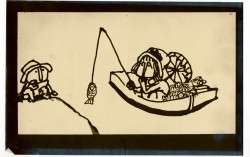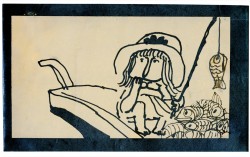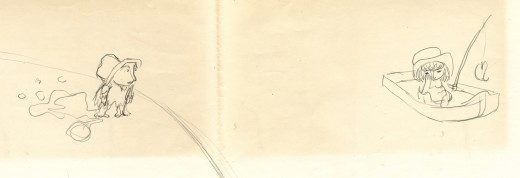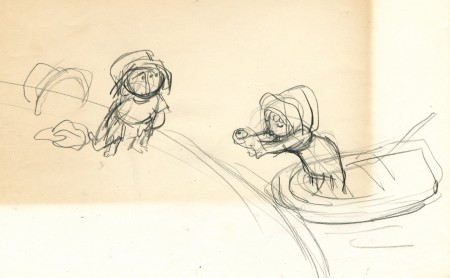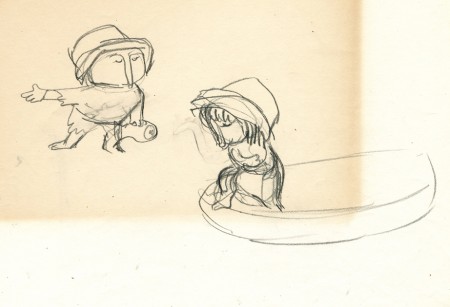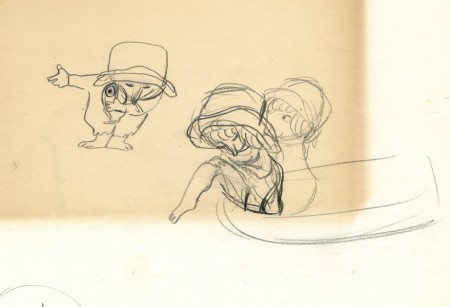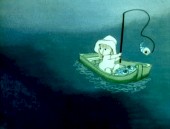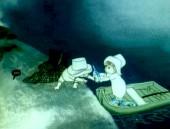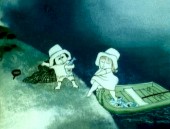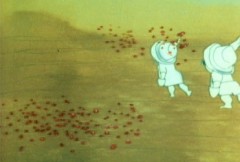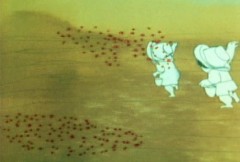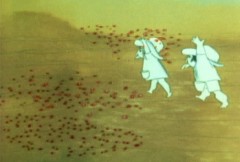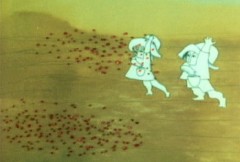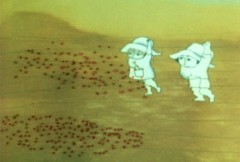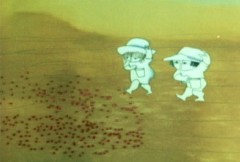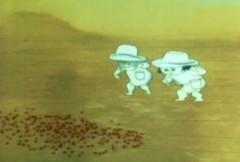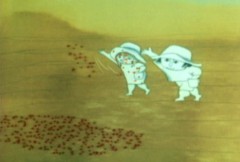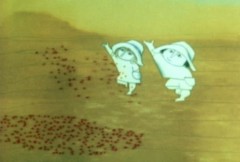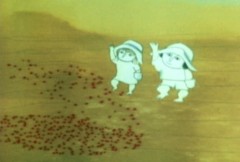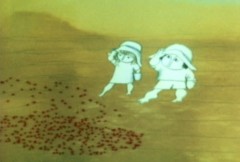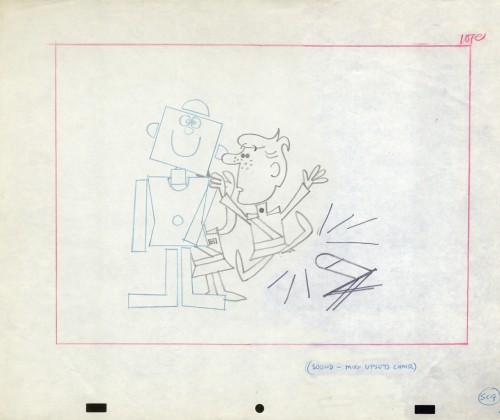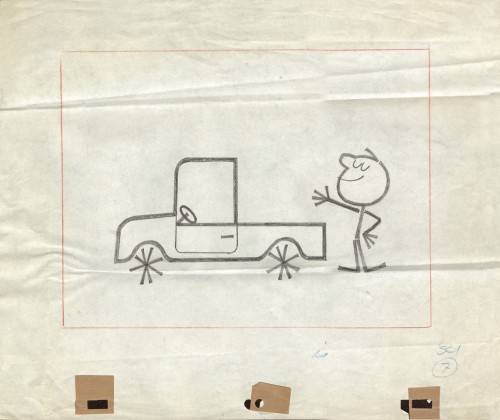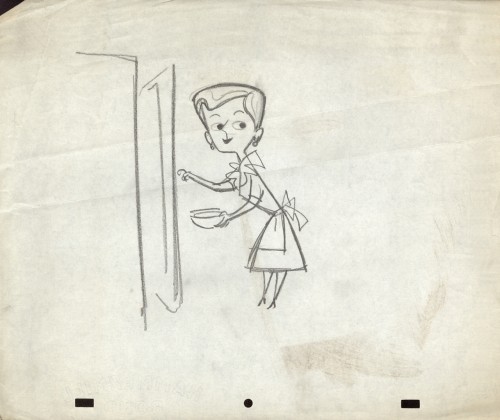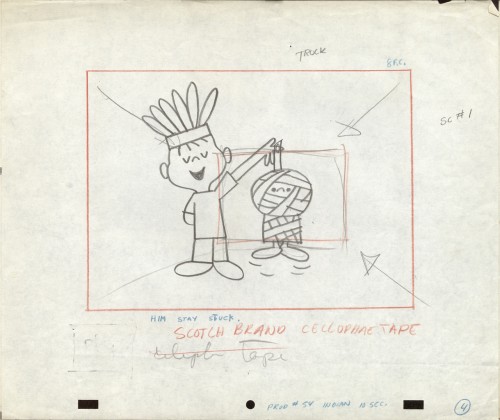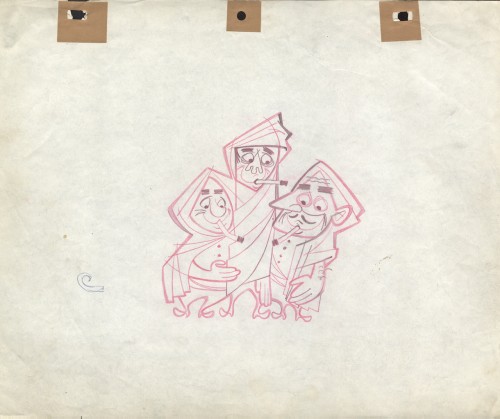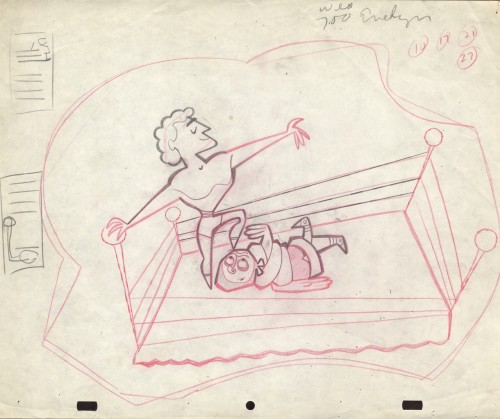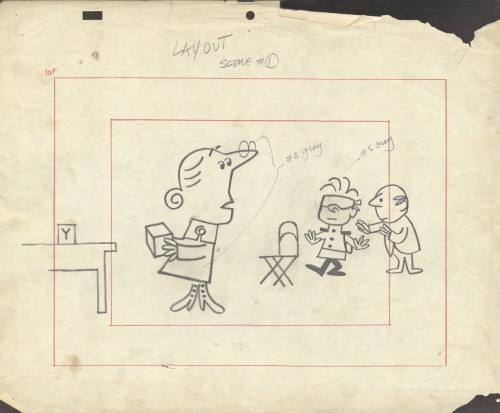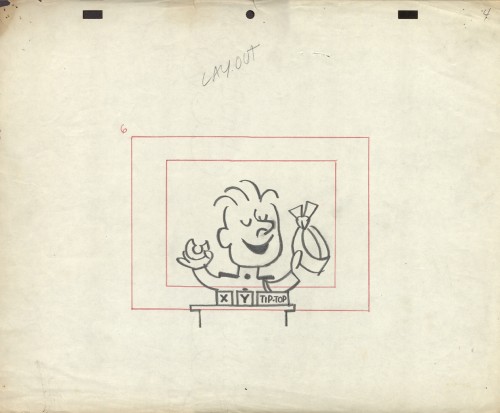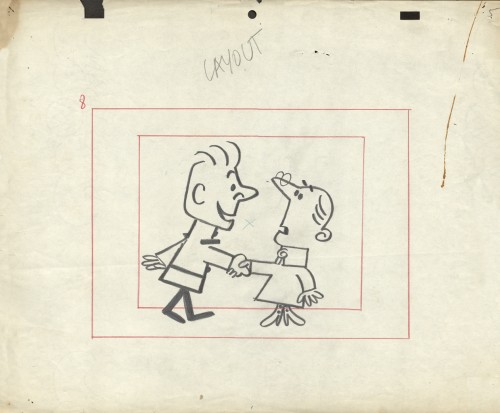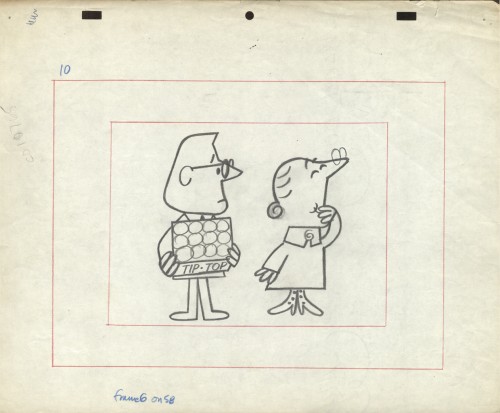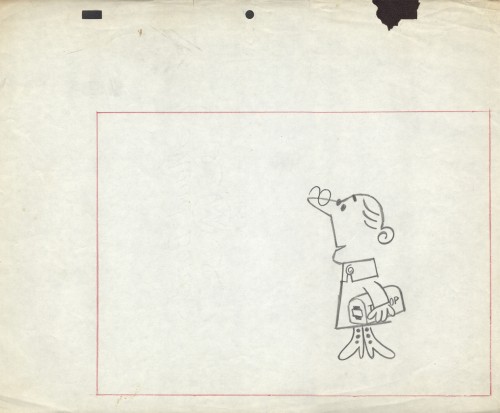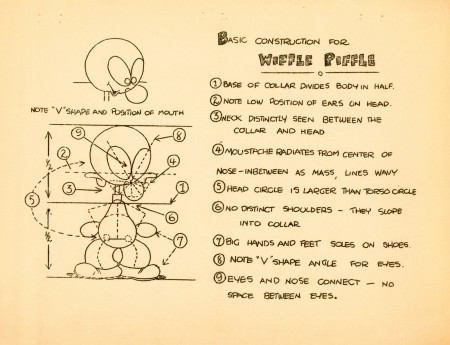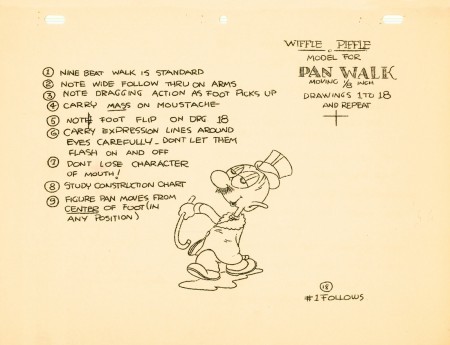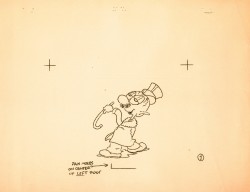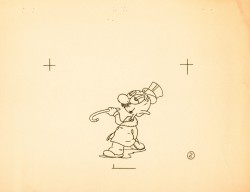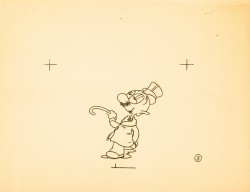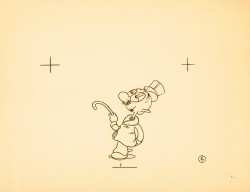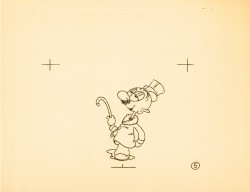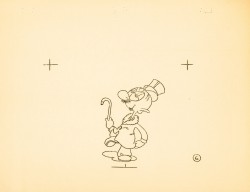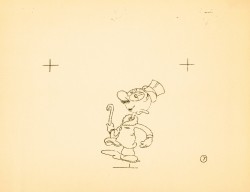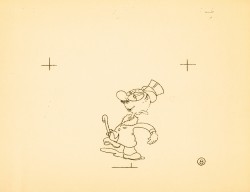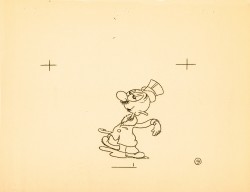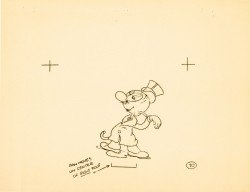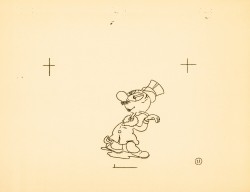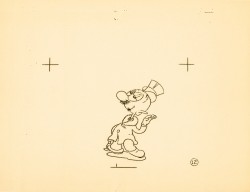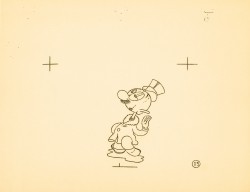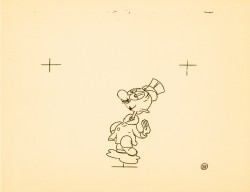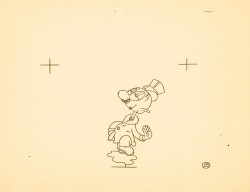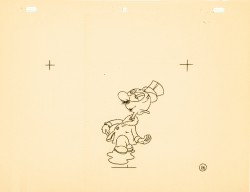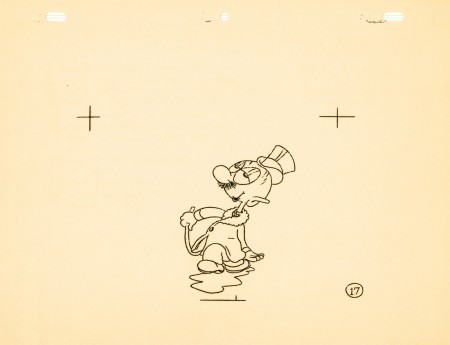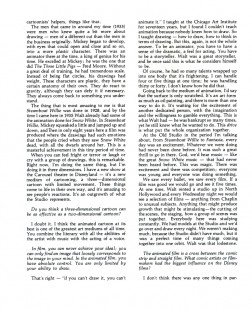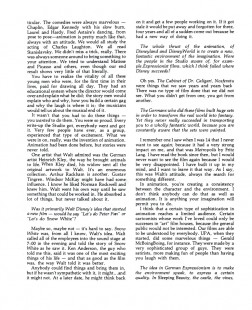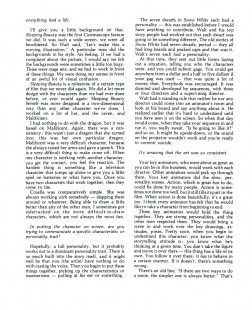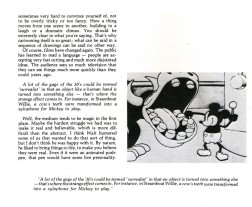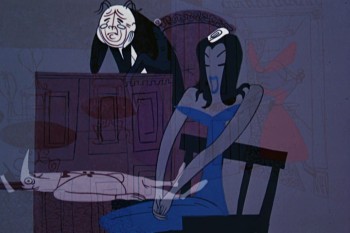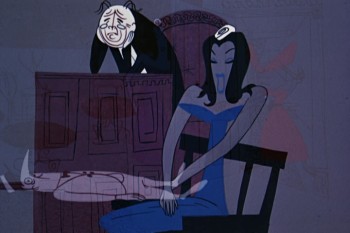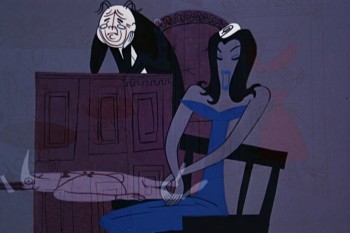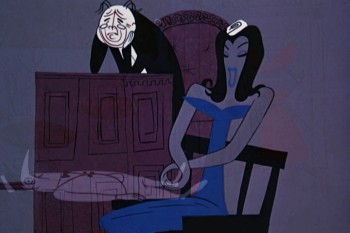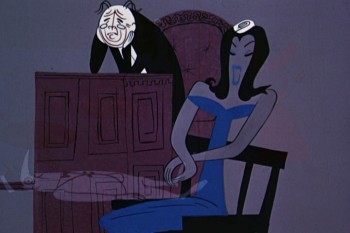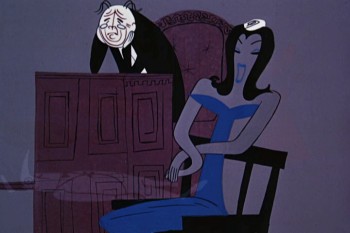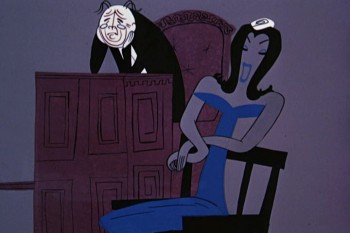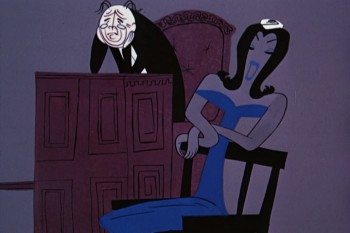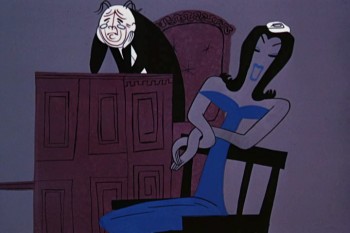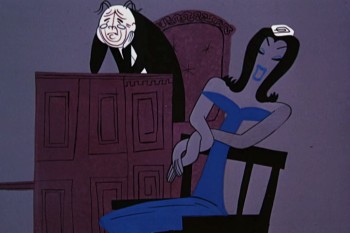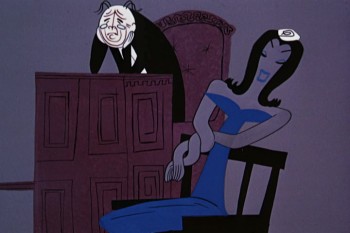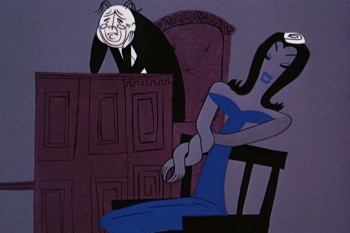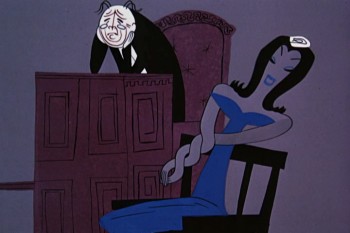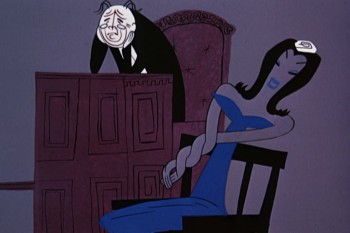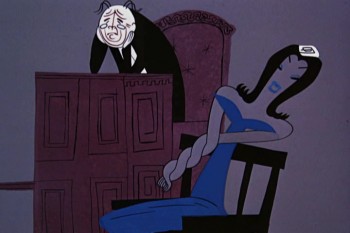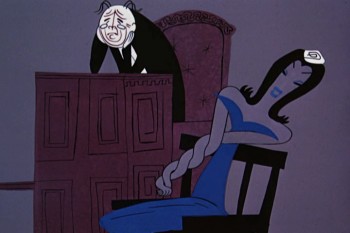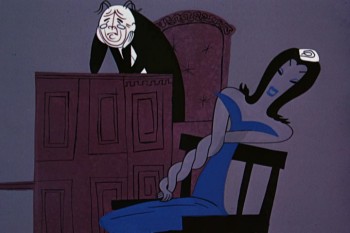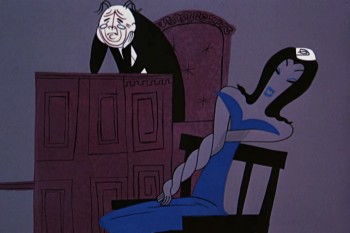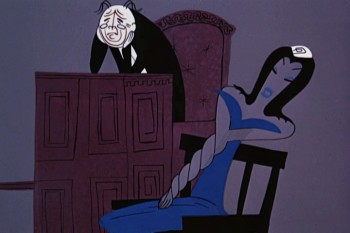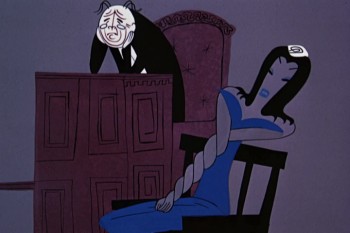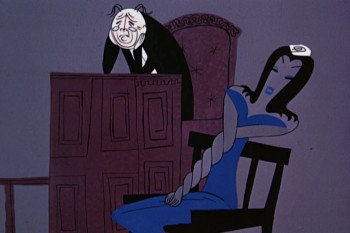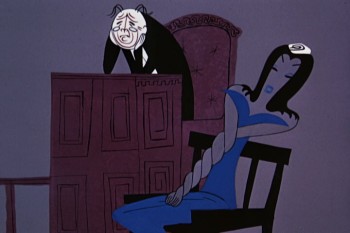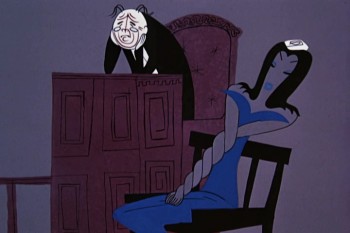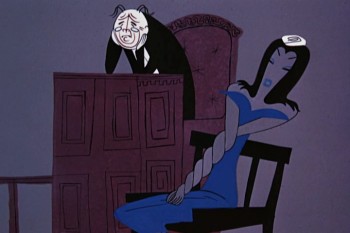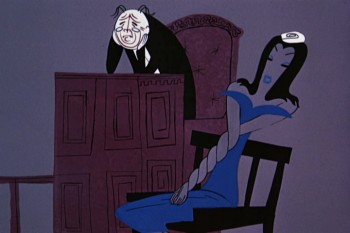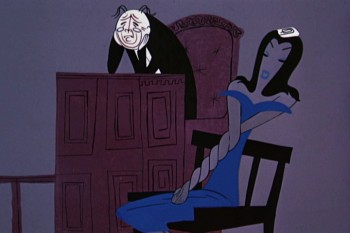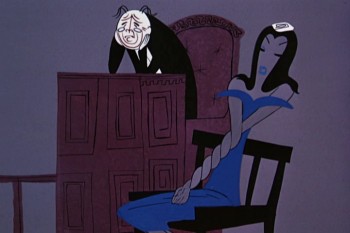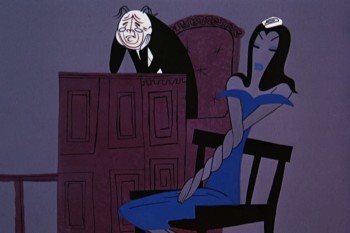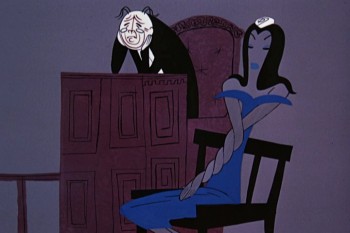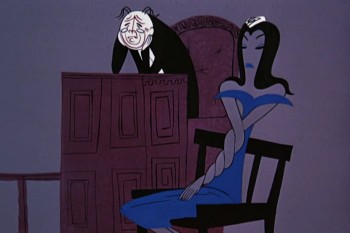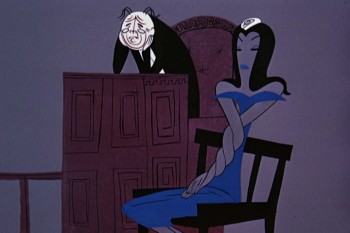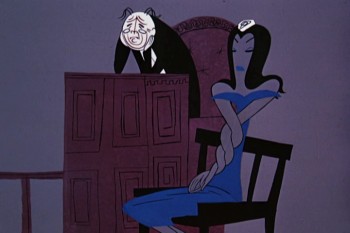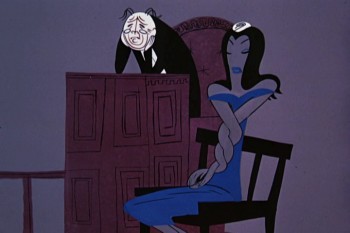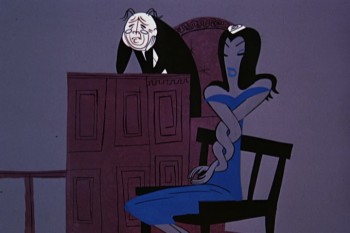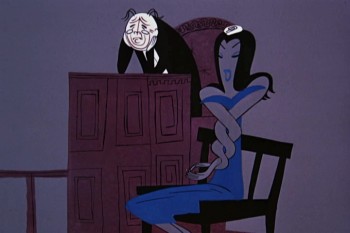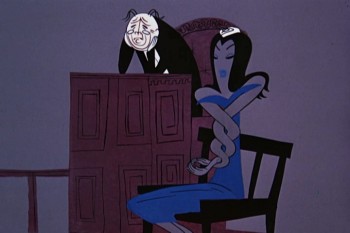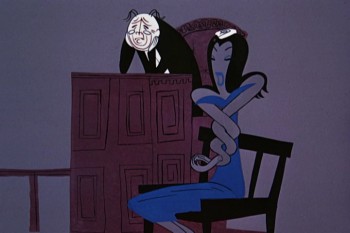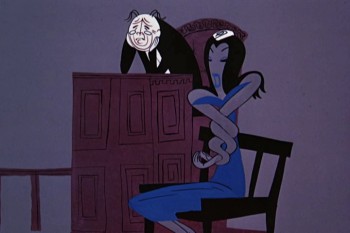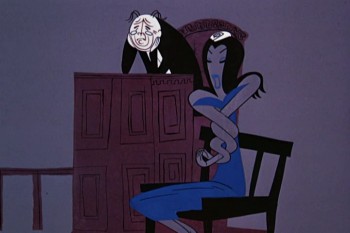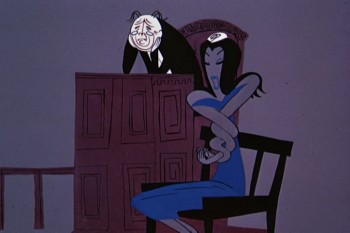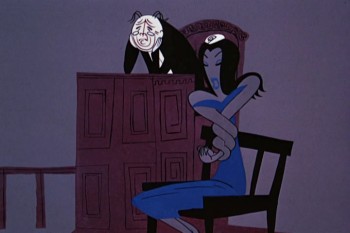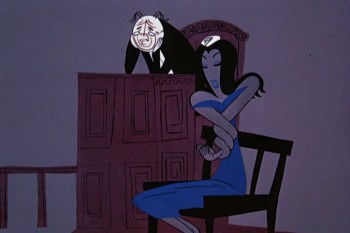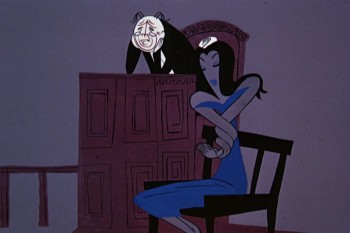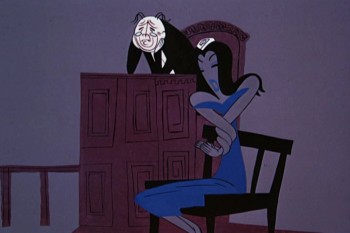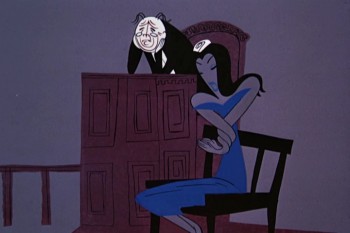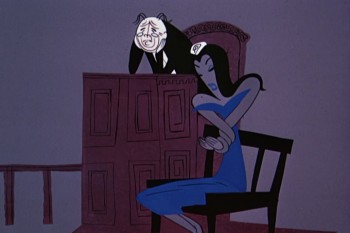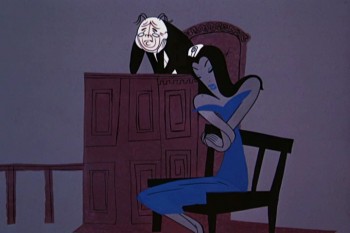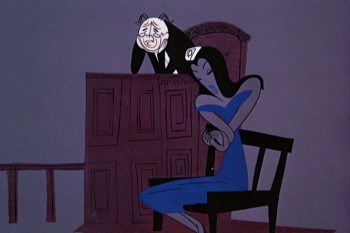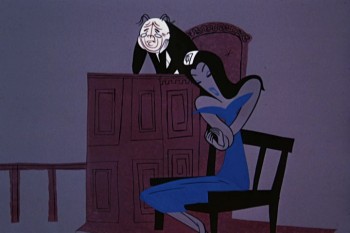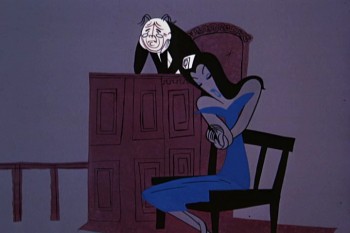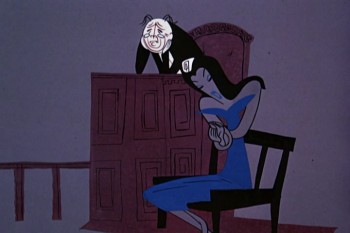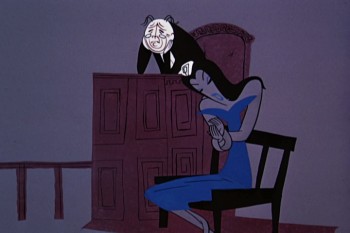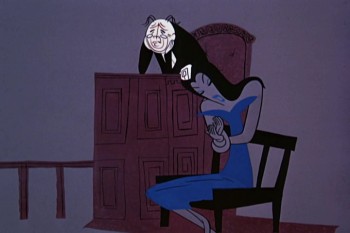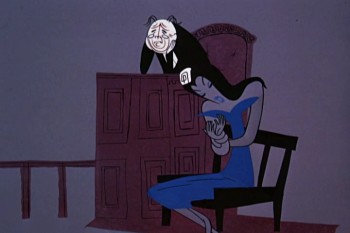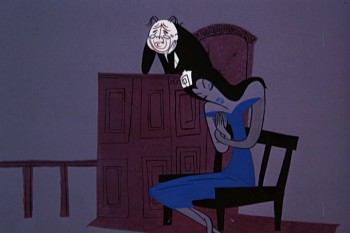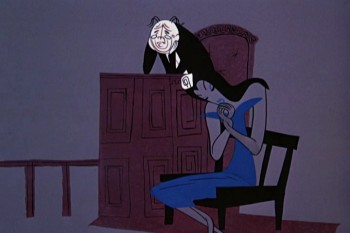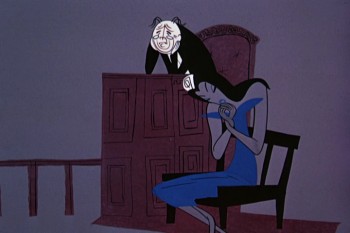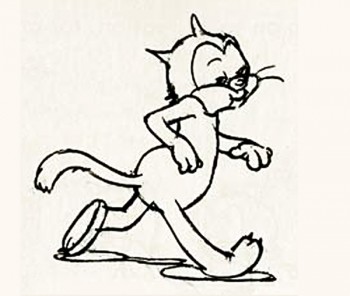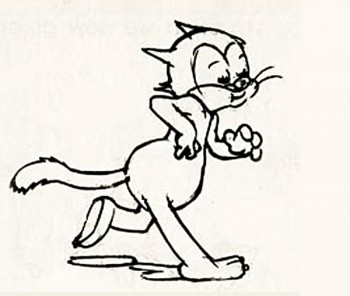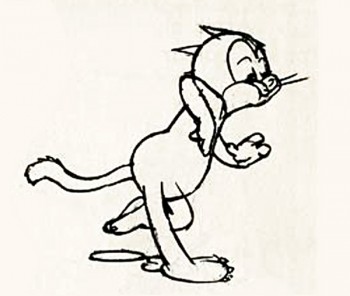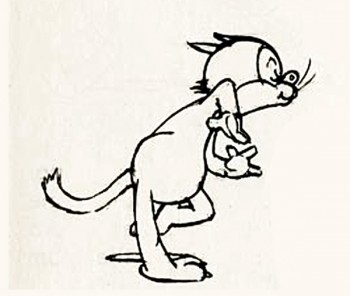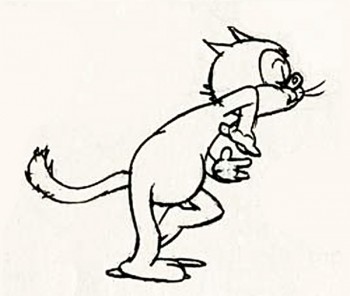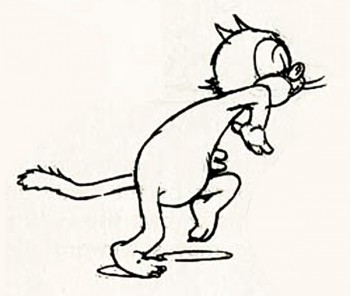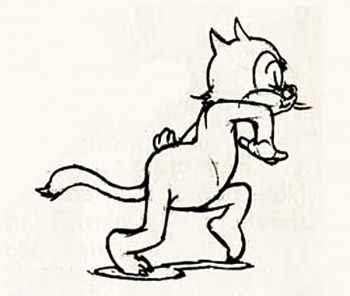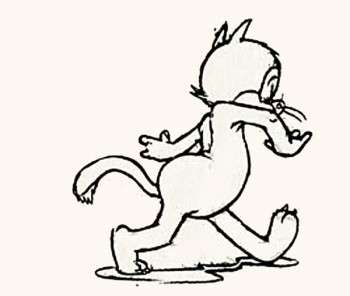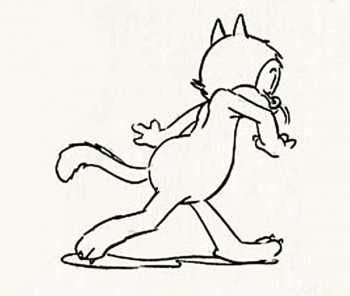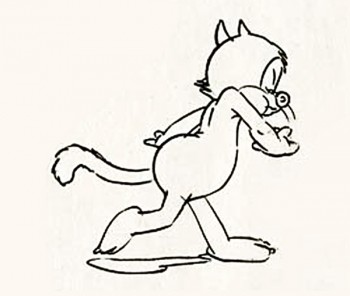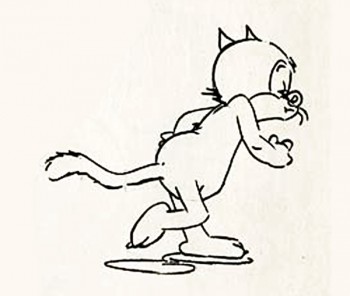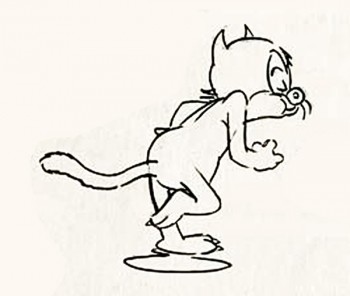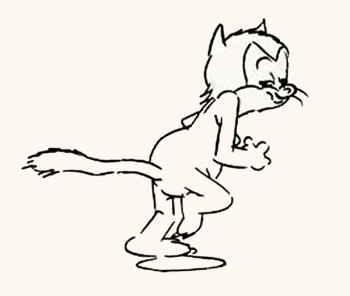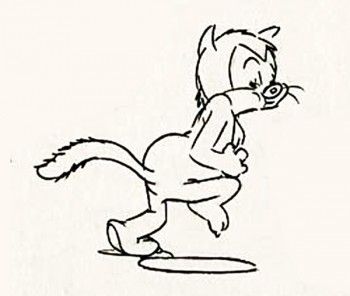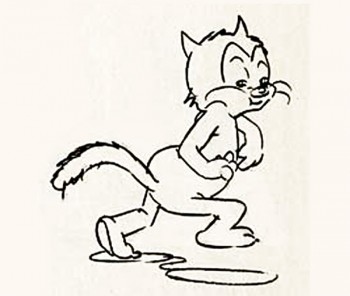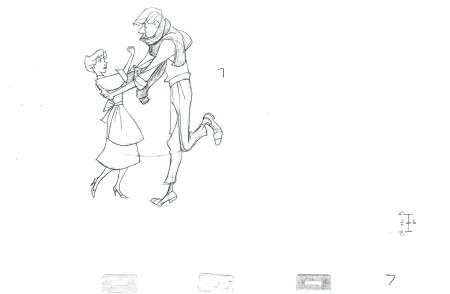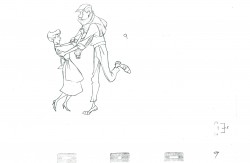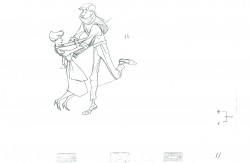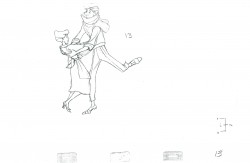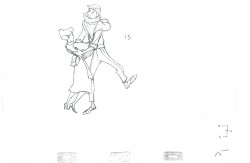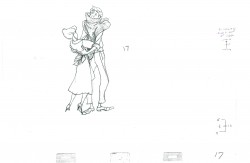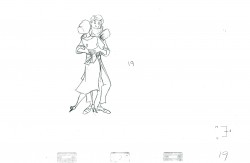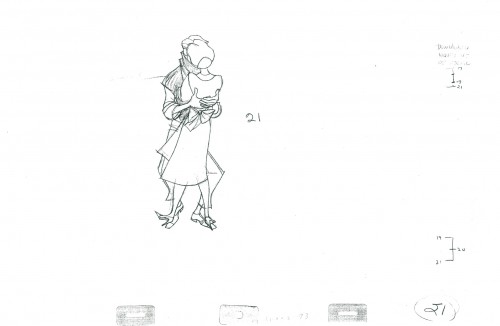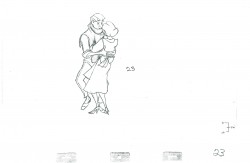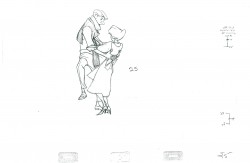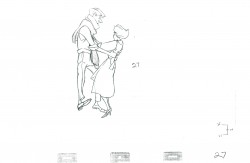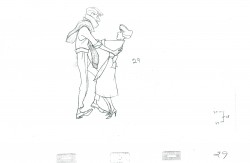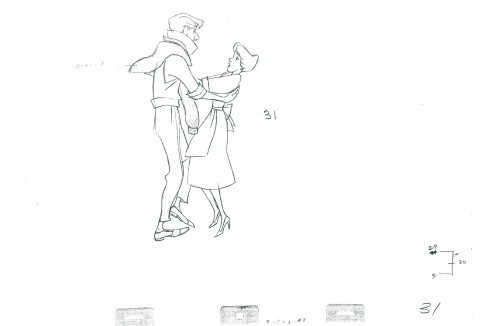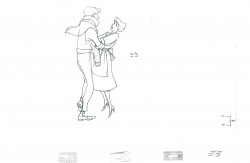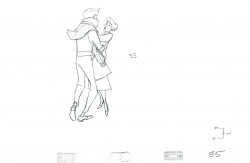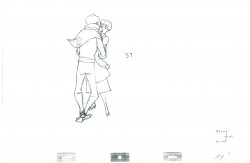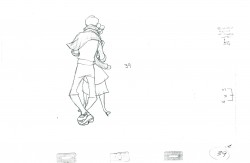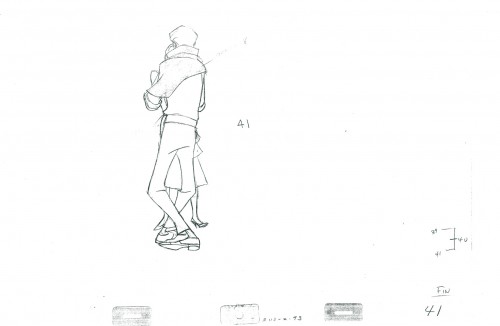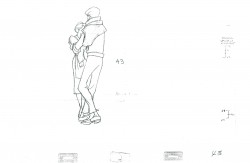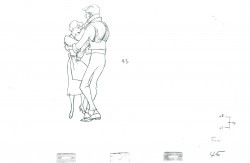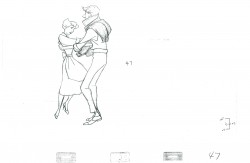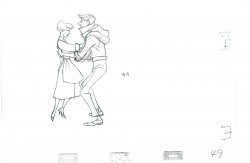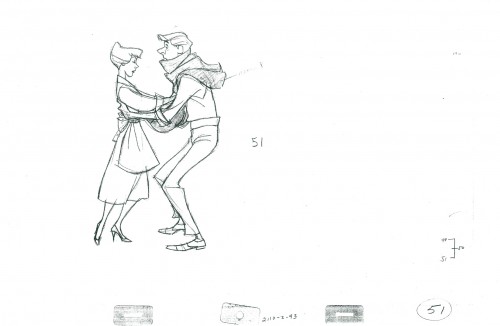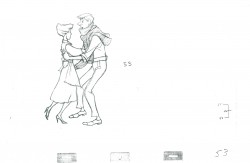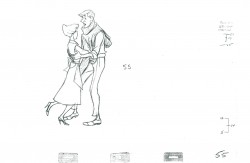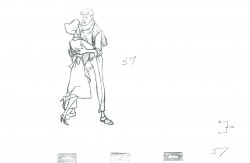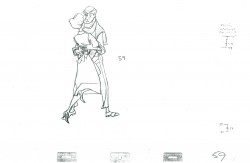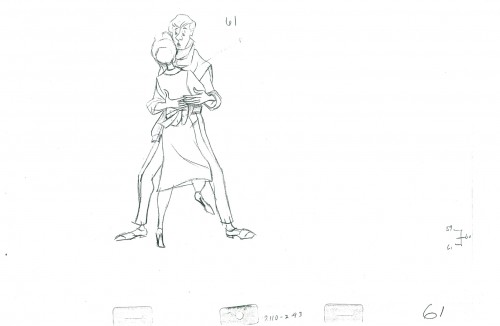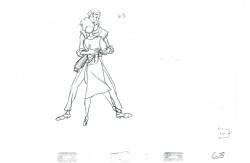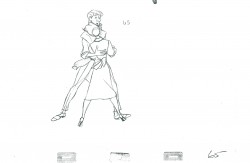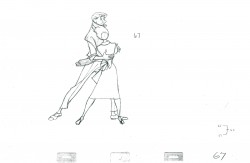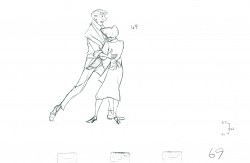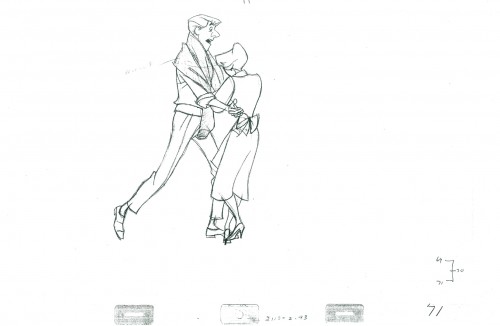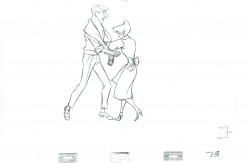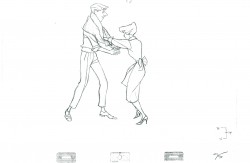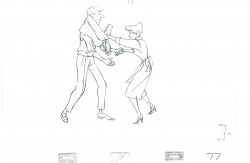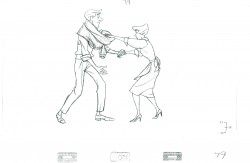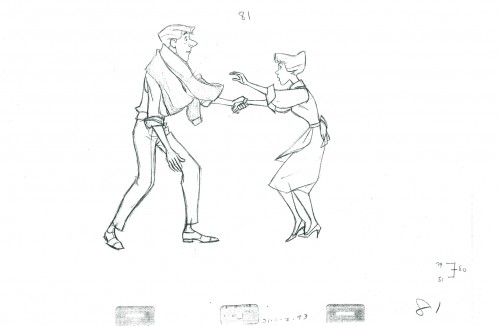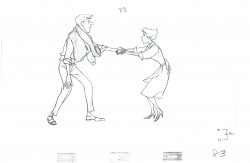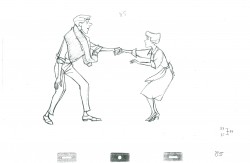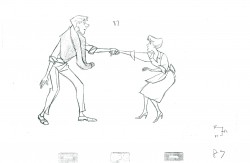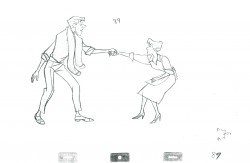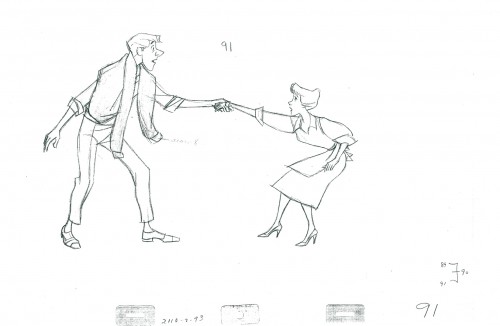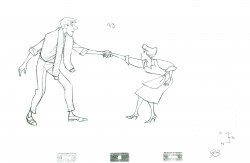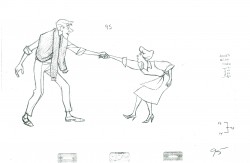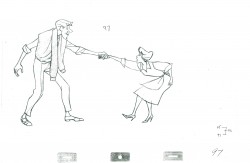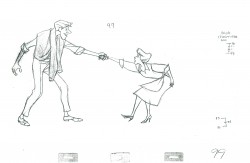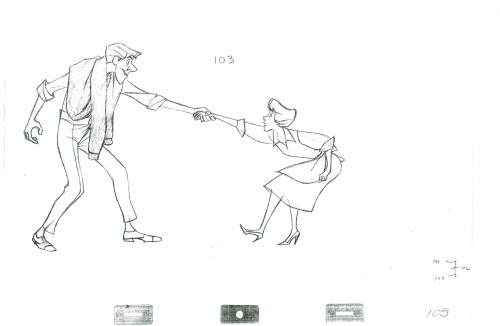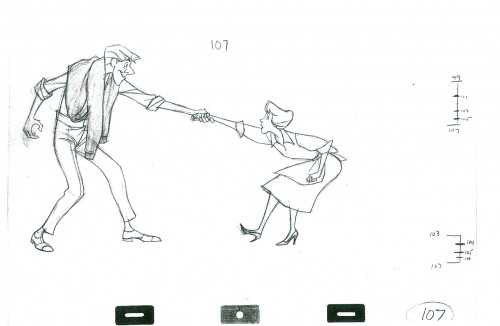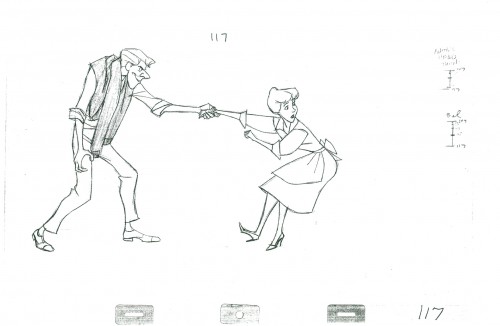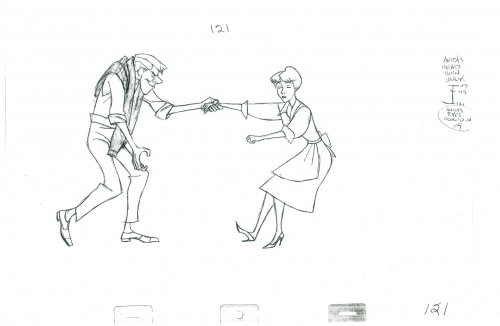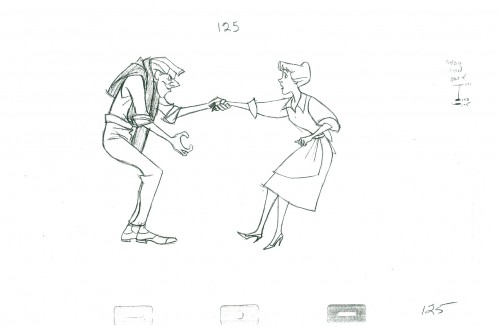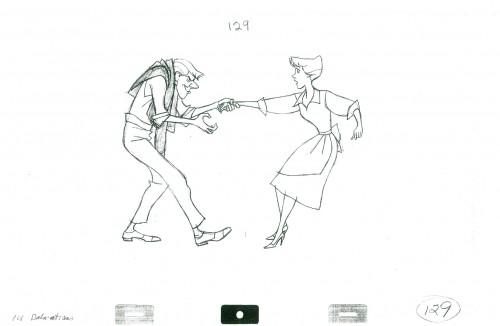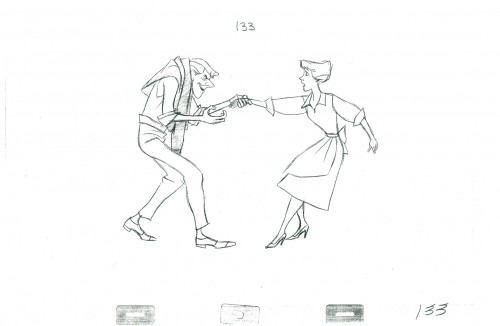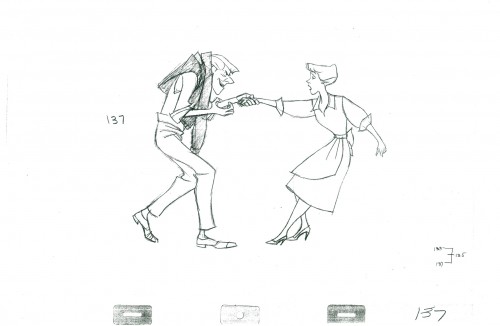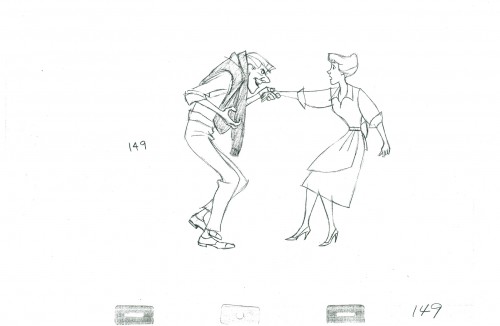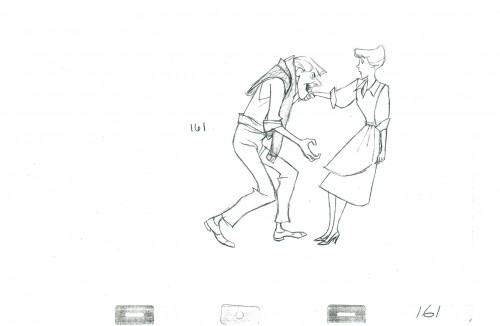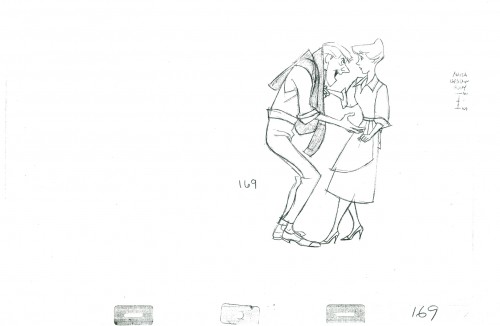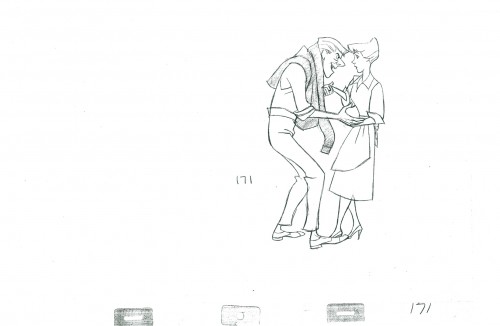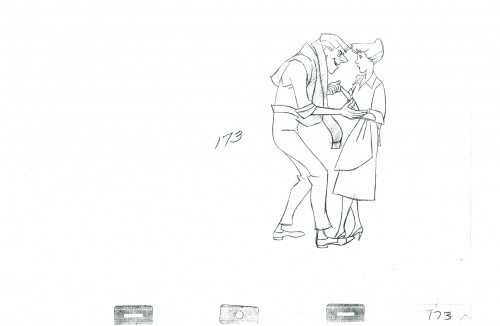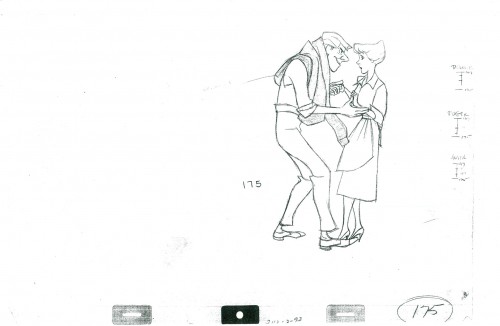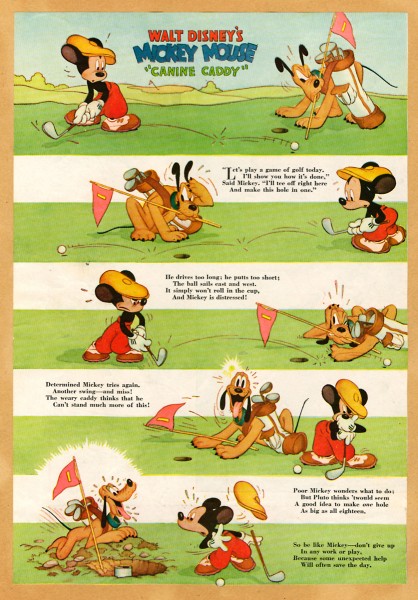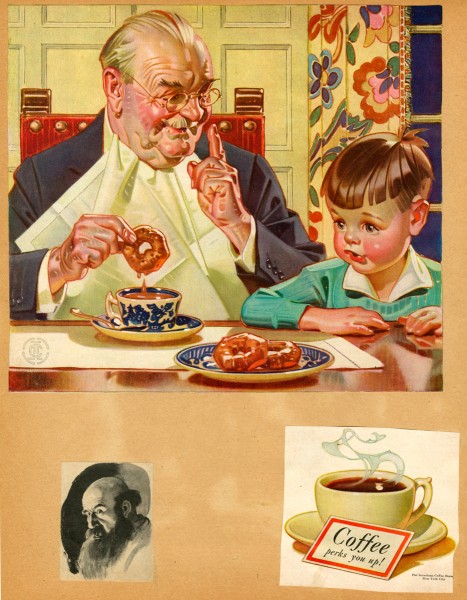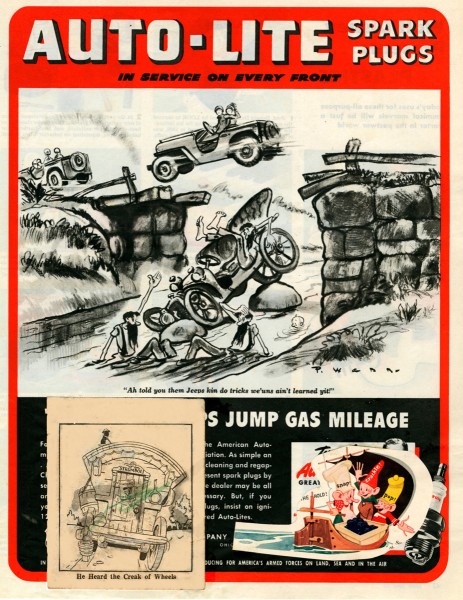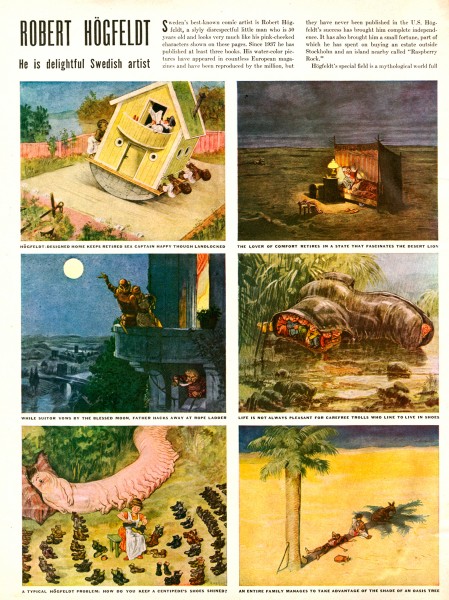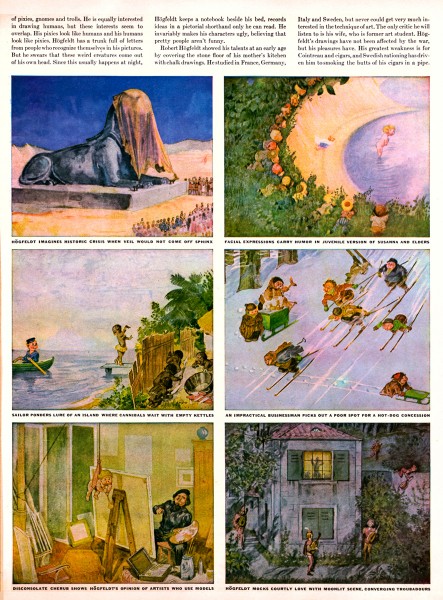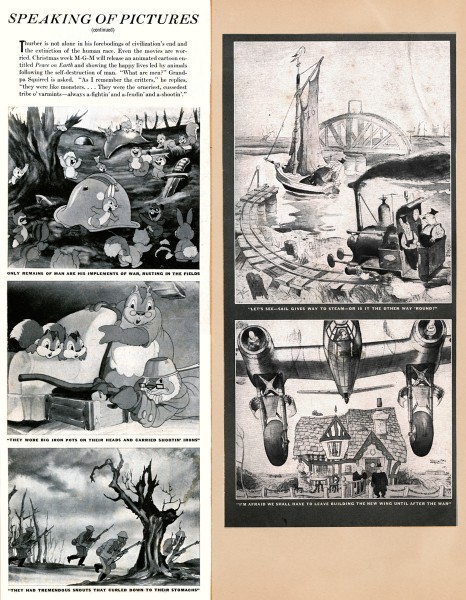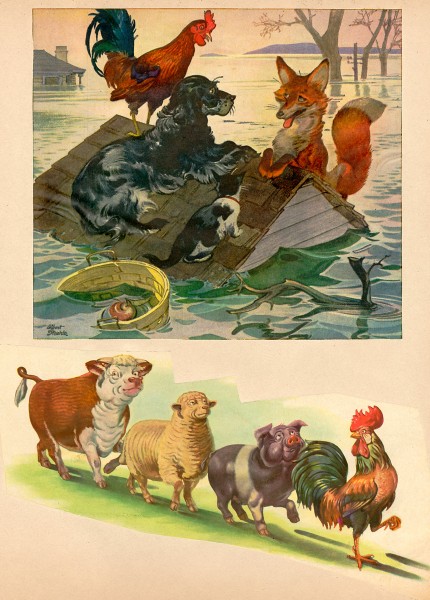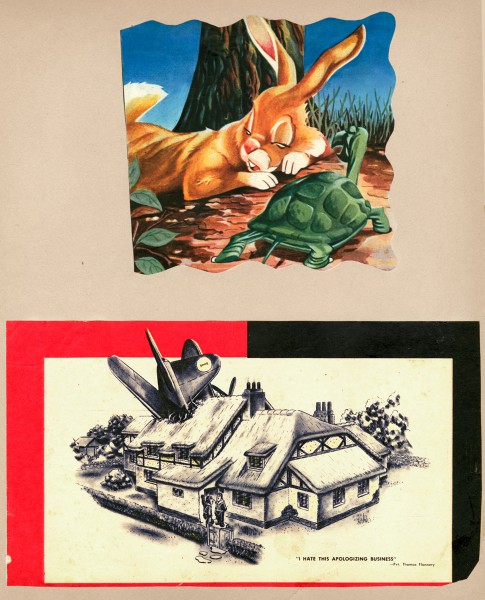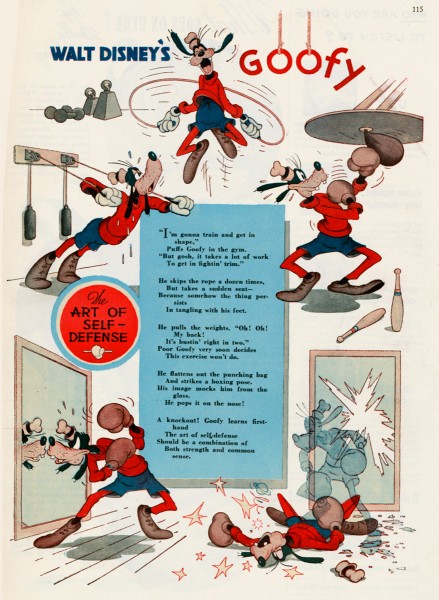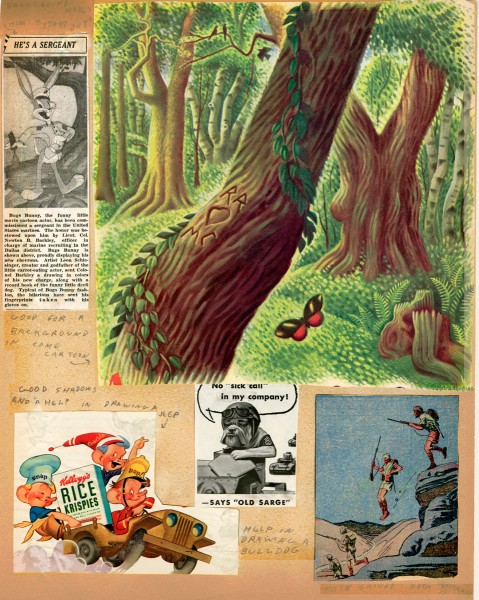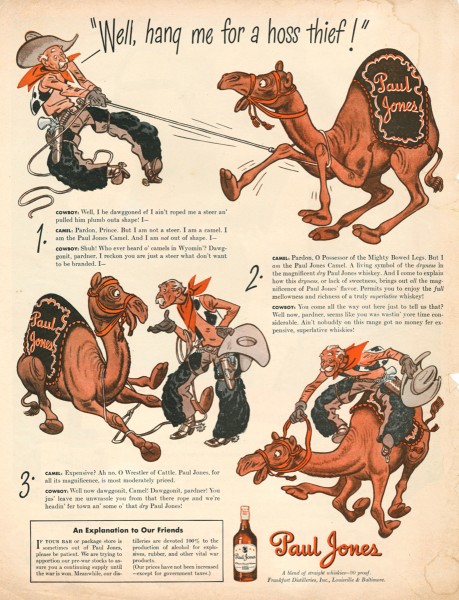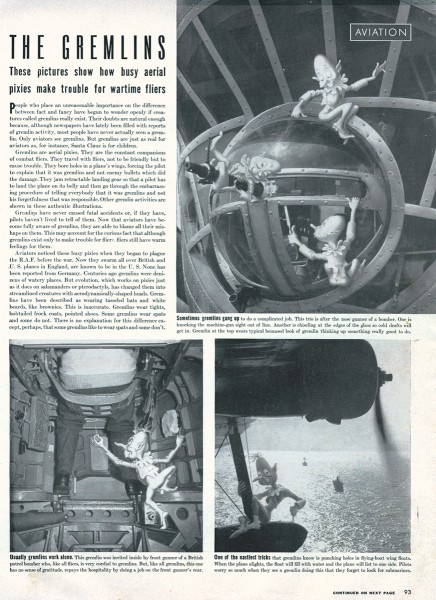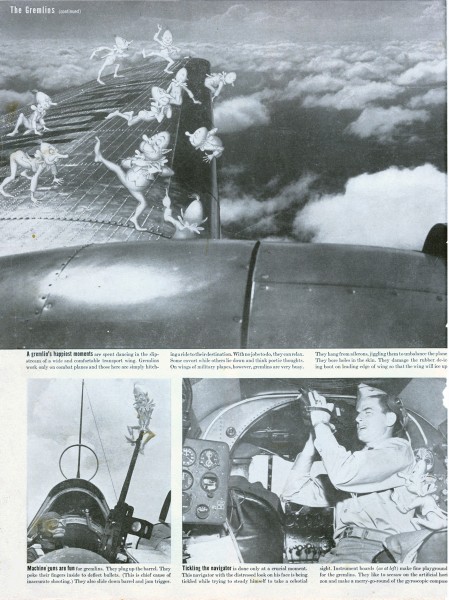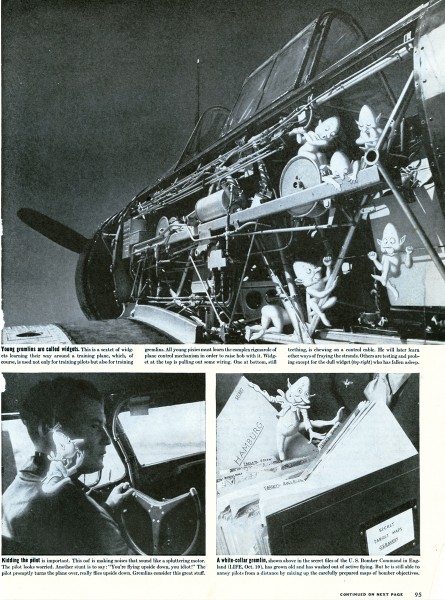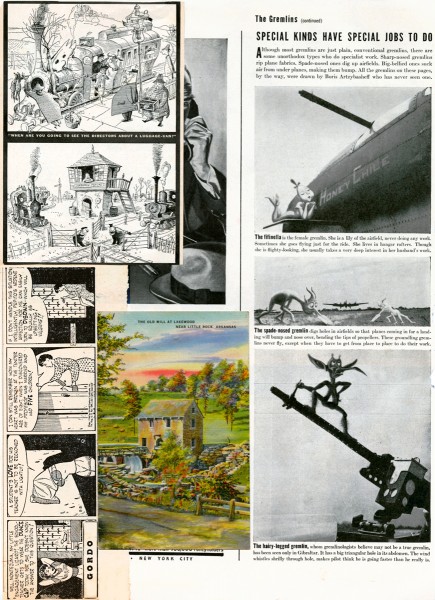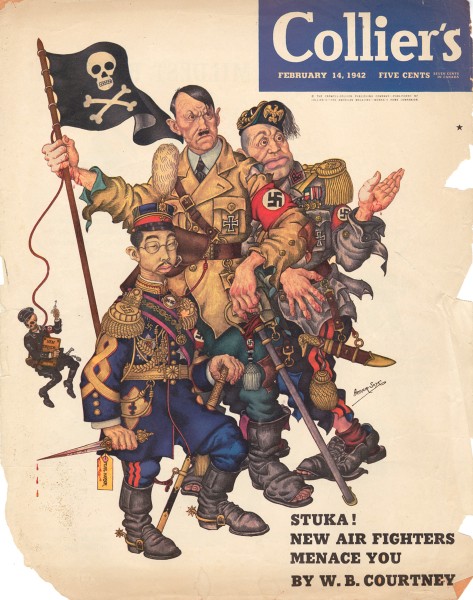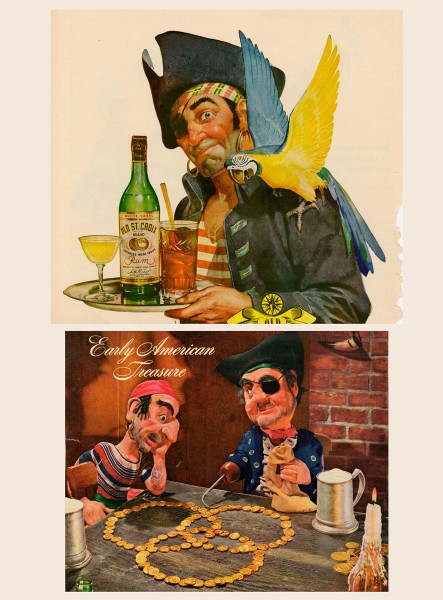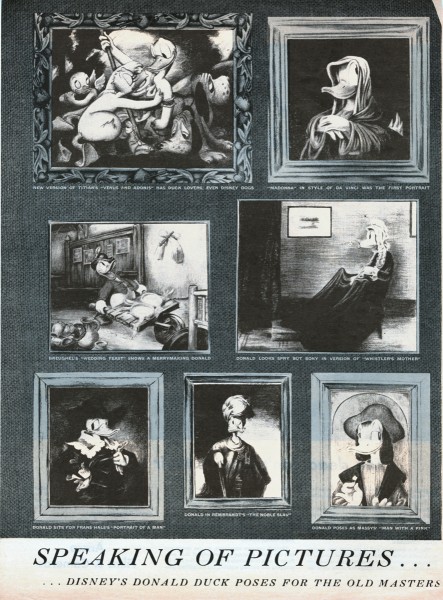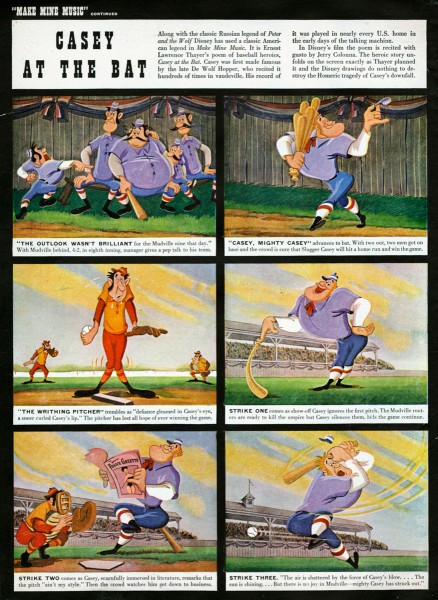Category ArchiveAnimation
Action Analysis &Animation &Animation Artifacts &Frame Grabs &Hubley &Independent Animation &Layout & Design &Tissa David 09 Jul 2012 05:24 am
Of Men & Demons – Redux
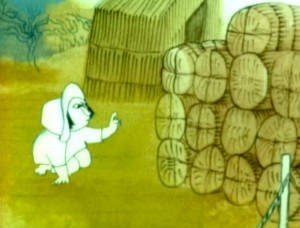 – Since first seeing the Hubley short, Of Men & Demons, back in 1967, I’ve been a fan. The artwork was stunningly different and original. It had a rich tone to it and some beautiful Hubley Bgs. The music by Quincy Jones was as original as the film, itself.
– Since first seeing the Hubley short, Of Men & Demons, back in 1967, I’ve been a fan. The artwork was stunningly different and original. It had a rich tone to it and some beautiful Hubley Bgs. The music by Quincy Jones was as original as the film, itself.
The short was actually an industrial film done for IBM to explain the binary code to its employees. The Hubleys, however, built on that story to make something of a personal film that received an Oscar nomination.
(Click any image on the page to enlarge.)
Art Babbitt was one of the first animators hired. At some point, Tissa David was brought on to rework some of Babbitt’s beautiful animation. Unfortunately, it was on about fourteen levels and had to be combined and reconstructed and shortened. (Today, of course, there are no limits to levels, but in the days of the camera you kept things to 4 cel levels, as a rule, and never more than 5.) It was complicated by the fact that John Hubley had decided to shorten the piece, and Quincy Jones’ score was shorter than Babbitt’s animation. This chore took some effort and involved dissolve animation. Tissa then continued on the sequence animating the little protagonist and his female companion through the remainder of the film.
About 25 years ago, Tissa David gave me an envelope full of art from this film, and going through a lot of my old material recently, I came upon that envelope.
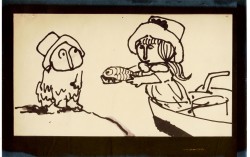 3
3 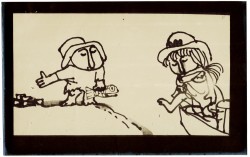 4
4
These are storyboard drawings for a short sequence. Tissa got these drawings and prepared Layouts for the sequence. You can see how much is actually in John’s drawings so it’s easy to build on what he’s given you.
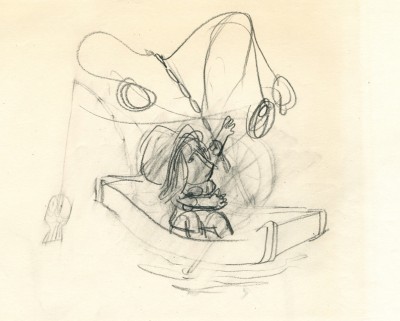 1
1The following are key drawings Tissa prepared for the sequence in laying it out.
Here is a short piece that Tissa did of the little woman character seeding her front yard. There’s so much grace in every one of these drawings and enormous information in the walk, itself.
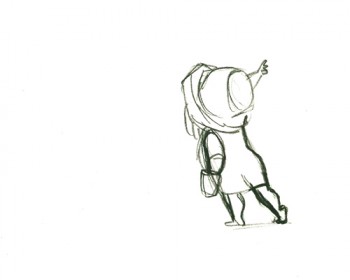 G47
G47(Click any image to enlarge to full animation sheet.)
.
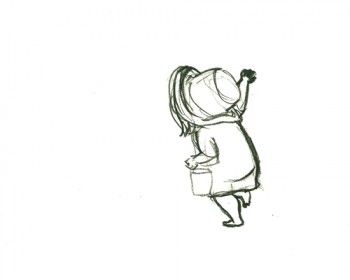 G49
G49.
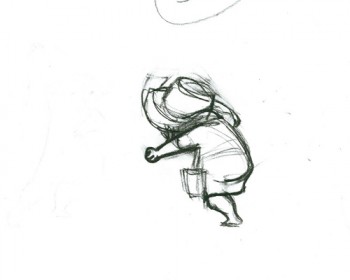 G51
G51.
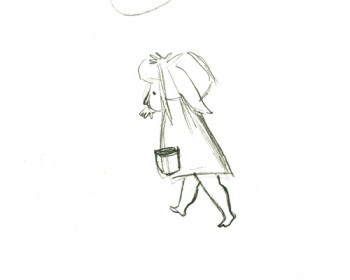 G53
G53.
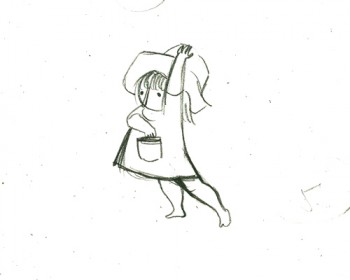 G55
G55.
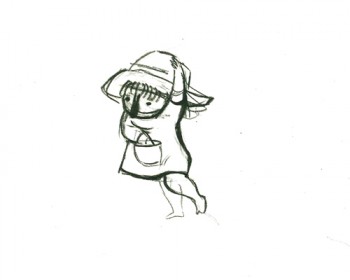 G57
G57.
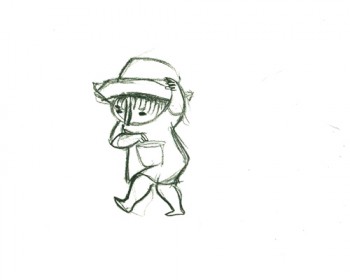 G59
G59.
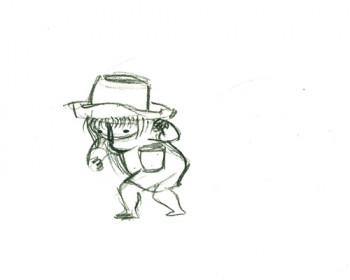 G61
G61.
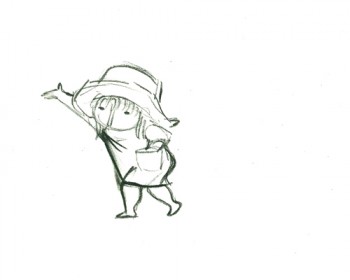 G63
G63.
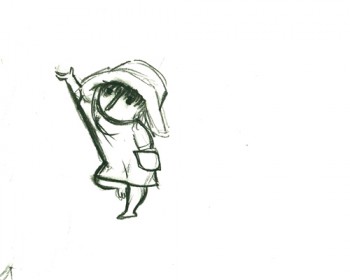 G65
G65.
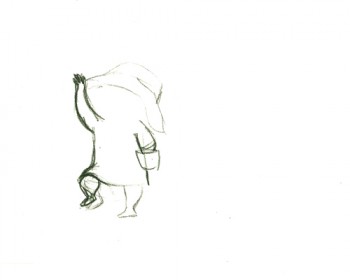 G67
G67.
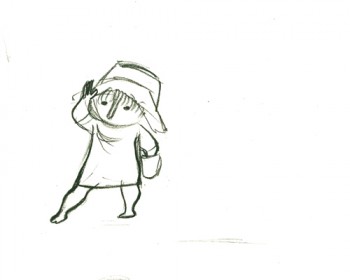 G69
G69
And here are the matching frame grabs from the film.
Seeding crops PT & Final Color
Animation &commercial animation &Layout & Design &UPA 27 Jun 2012 05:44 am
UPA Commercial Layouts
- Having swept through Vince Cafarelli‘s collection of Fleischer/Paramount artwork, We move onto the next box which is his commercial work. Vince was an Assistant Animator at UPA New York. He saved a group of layout drawings for some of the commercials. Unfortunately, only a few are marked as to what the sponsor was. so it amounts to a number of drawings which often have no relation to each other.
However, the drawings included all are good representation of the beautiful and diverse design employed at the studio. Here are a first group; when I can identify the spot, I will. If you recognize any of them, please let me know.
The peg system used throughout is called “Signal Corps.” This is where the size of pegs was first used. By this time, New York animators had three different sized pegs to use: Acme, imported from California;
Signal Corps, a hold-over from the Army, and
Oxberry, invented just after the War by John Oxberry.
They all had their different advantages, and they all remained in use through the 80s, when Acme finally took over.
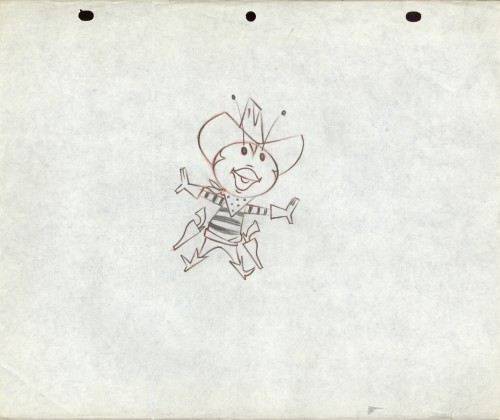 1
1Mark Kausler commented: “… the first two are “Buffalo Bee†from
the Nabisco Wheat Honeys commercials. Mae Questel was the voice,
they appeared on the early Mickey Mouse Club shows, 1955-56.”
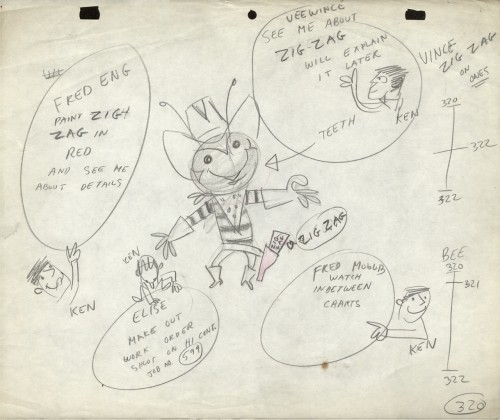 2
2
Note how the animator leaves notes for the crew who will work on the spot.
“Vince” was the Assistant Animator. “Fred Mogubgub” was the inbetweener.
“Elise” was the checker/Prod. Coordinator, and “Fred Eng” the talented inker.
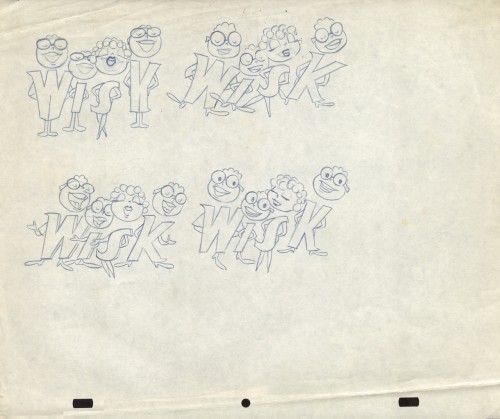 7
7
This is obviously for a Wisk commercial.
The final six LO drawings are Emily Tipp for Tip Top bread.
She was a very successful spokesperson for the bread company.
These may have been done at Kim-Gifford Studios rather than UPA.
I kept them with UPA because the peg system is consistent
with other UPA commercials.
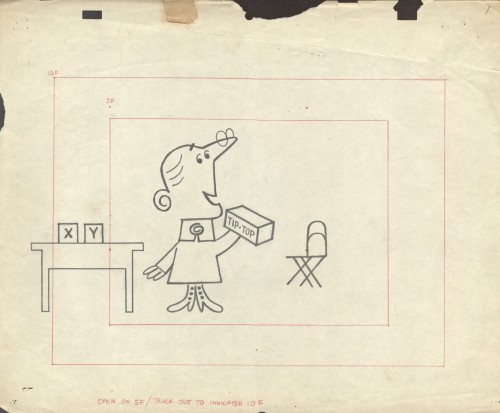 10
10
To see some of the Emily Tipp spots go here
at the Buzzco website.
Animation &Commentary &Hubley &Independent Animation &Layout & Design &repeated posts 25 Jun 2012 06:29 am
Everybody Rides – repost
I posted this in the summer of 2008. I’ve ganged two parts together to make one read.
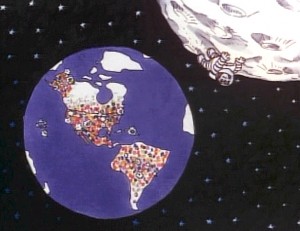 - Back in 1976, I was working on John Hubley‘s Bicentennial flm, PEOPLE PEOPLE PEOPLE. This was a short film, four minutes long, that had about a million scenes. It told the history of the US (from the standpoint of populating and overpopulating) beginning 17760 BC and ending in 1976 AD.
- Back in 1976, I was working on John Hubley‘s Bicentennial flm, PEOPLE PEOPLE PEOPLE. This was a short film, four minutes long, that had about a million scenes. It told the history of the US (from the standpoint of populating and overpopulating) beginning 17760 BC and ending in 1976 AD.
It started with some lengthy scenes. As the film moved on, the cuts came faster, until they hit about 6 frames apiece toward the film’s end. The final scene, from space, was the longest in the film.
There were no characters that appeared in any more than one scene. That meant that with each scene, there were new setups, new characters, new colors, new everything. As a result, it took much longer than other films and was a difficult one to pull off. But like all other Hubley efforts, it was fun. Tissa David, Jack Schnerk, Lu Guarnier, Phil Duncan and Bill Littlejohn animated it. I colored about 2/3 of the film and animated at least a dozen or two scenes (some really were only 6 frames – like that auto shot posted). I also assisted/inbetweened all of the animators.
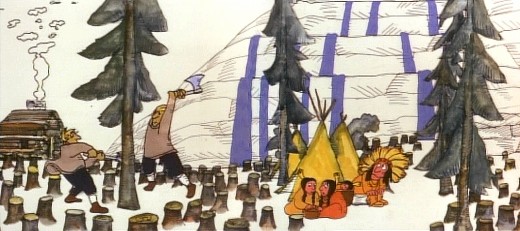
Swedes cut down all the trees in PEOPLE PEOPLE PEOPLE.
The studio, at the time, was buzzing because John and Faith had just sold a dream project to CBS. EVERYBODY RIDES THE CCAROUSEL was an adaptation of Erik Erikson‘ 1956 book, Eight Stages of Development. Erikson was a psychologist who theorized that man goes through eight stages of development from birth to death, and he proceeds to break them down. The Hubleys took this book and broke these eight stages into horses on a carousel.
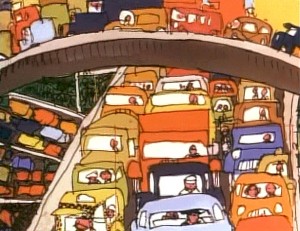 The three half hour Special shows for CBS would be about these carousel horses and the ride.
The three half hour Special shows for CBS would be about these carousel horses and the ride.
Each of the stages would be broken into two different subsets, and these would be depicted through stories which were roughly developed visually by John and Faith. Once the funding started to tricle in (about $450,000 for all three shows) they would cast their many actors and have them improvise in the recording studios to the storyboarded set pieces.
While those recordings progressed, the small studio staff was busied in completing animation, artwork and rendering of PEOPLE PEOPLE PEOPLE.
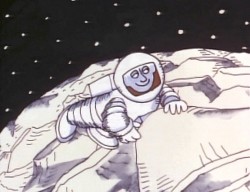
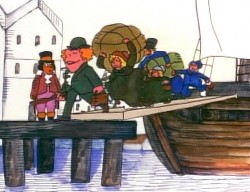
The man on the moon and the Irish immigrants.
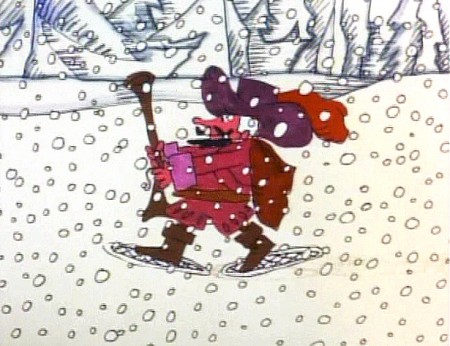
Jack Schnerk animated the French trapper sequence. There was such a rush
on the scene that I remember Jack bringing it in saying he hoped it would work.
He’d done two drawings of snow for the blizzard. Both wildly different from each other.
He asked me to ink them, then flop the drawings and ink them again.
He’d exposed the four drawings on fours. He also had the trapper with
snowshoes walking on fours. He felt it would help us feel a struggle in his
walking through the snowstorm. He felt the fours might add weight.
The scene worked beautifully, and was excellent the first time out.
Not quite the way they’d have done it at Disney. Tricks of the trade.
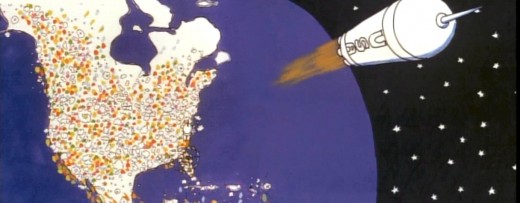
Tissa animated a majority of the film. The ending, the man going to the moon to escape
the overpopulated earth was hers. I have the drawings somewhere and will post some of them soon.
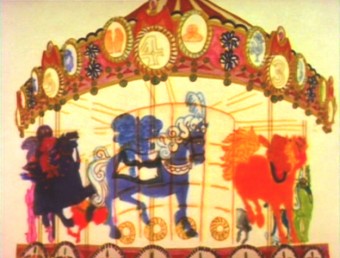 – We started slowly on Everybody Rides the Carousel. There was a six month schedule for about 72 mins of animation. Three half-hour original tv shows for CBS about 24 mins each. They’d air in the late summer of 1975 just prior to the start of the new tv season. Each show would air a day apart from the others – three nights in a row.
– We started slowly on Everybody Rides the Carousel. There was a six month schedule for about 72 mins of animation. Three half-hour original tv shows for CBS about 24 mins each. They’d air in the late summer of 1975 just prior to the start of the new tv season. Each show would air a day apart from the others – three nights in a row.
John and Faith spent a lot of time – a lot of time – at RCA studios on 45th Street. (It’s
____ The carousel was bottom lit & became soft focus.____-_ now an IRS office.) They recorded many of the voices playing the numerous parts in their show. I tried to time meeting them there a couple of times hoping to meet some of the actors (I particularly wanted to see Jack Gilford in action. He was doing an hilarious part with his wife, playing a couple of cranky old people in a diner.) It didn’t work out that way, but I did see the facility and heard parts in process.
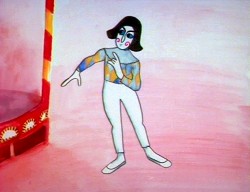 The key staff working IN the studio (not counting animators who would, for the most part, work freelance) included Ida Greenberg. Ida was a brilliant checker / coordinator who’d started back in the Florida days of the Fleischer studio. (She told me a few great stories about Gulliver’s Travels.) Ida was a great woman, with the thickest New Yowk accent, who never seemed to buckle under pressure. I grew very close to her. I tried after that to have Ida everywhere I worked. She led Raggedy Ann’s I&Pt and R.O.Blechman’s special.
The key staff working IN the studio (not counting animators who would, for the most part, work freelance) included Ida Greenberg. Ida was a brilliant checker / coordinator who’d started back in the Florida days of the Fleischer studio. (She told me a few great stories about Gulliver’s Travels.) Ida was a great woman, with the thickest New Yowk accent, who never seemed to buckle under pressure. I grew very close to her. I tried after that to have Ida everywhere I worked. She led Raggedy Ann’s I&Pt and R.O.Blechman’s special.
Kate Wodell was a student of the Hubleys at Yale. She was a talented artist who’d moved into production during the making of Cockaboody and continued on staff there. Sometimes she colored, sometimes she animated, sometimes she did whatever was necessary. This was exactly how I moved into the studio and loved the experience. She worked with Faith for many years after John died.
Earl James was an animator who’d worked in the backroom of many NY studios from Paramount to Terrytoons to NY Institute of Technology. He also had done some comic strip work.
Earl was given the carousel to animate. This came from a couple of elaborate drawings John did. Earl worked 16 fld. using a 96 drawing cycle. It gave us a lot of opportunity to move in tight or stay wide. However, it was a nightmare that took forever. Joe Gray was hired to assist Earl. (Joe started during the Terrytoons strike and never left. Many of those who knew him as a “scab” never forgave him and had only horrid things to say about him to me some thirty years later. He was a lifetime assistant like a handful of other noted names in NY.)
This scene moved so slowly through production that I kept jumping in to assist as well. I was a fast assistant, but that carousel slowed even me down. 8 horses moved in perspective in a circle; there were 96 different rotating views of all the horses. I’d guess the scene took about 10 weeks to complete.
I was also doing layout and animation of a lot of connecting scenes throughout the production. These were scenes that would have to blend from one animator to another, or John had decided to go in tight for a closeup. In one case with Art Babbitt’s mime character, I was asked to change it from two’s to four’s with a dissolve technique John taught me (he said they’d used it on Fantasia.)
There were four people in my room, Earl, Joe, me and Mark Hubley. He worked alongside me for most of the film. He colored artwork given him by Ida, who was working in the larger room next door. Mark and I had a good releationship going back the many years I worked there. He joined the studio once he completed college. Emily Hubley worked alongside Kate and Ida.
Two younger, more experimental animators were brought in by John. Adam Beckett had made a name for himself with the films he was doing at CalArts.
Fred Burns was doing some incredible work at UCLA. They both were very different and added their unique touch.
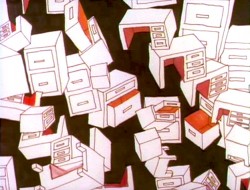
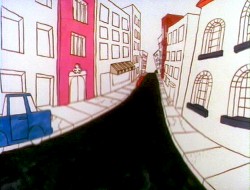
___________ Adam Beckett’s scenes included these two surreal images.
Adam did a scene a couple of scenes wherein office furniture floated about in a very complicated surreal cycle. Fred did this amazing scene of a roller coaster from the POV of the rider. He and I worked together a number of times after that, and we’ve stayed friends.
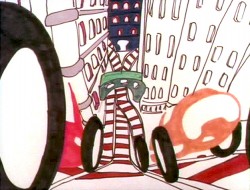
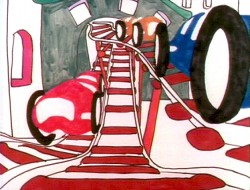
______________ Fred did this very elaborate sexual roller coaster.
I hope to have more to say about some of these films I worked on.
Animation &Animation Artifacts &Fleischer &Models 24 Jun 2012 05:33 am
Wiffle Piffle – repost
This character is really every thing you need to know about Fleischer animation. Animated by Tom Johnson the guy’s alive, and he’s nothing more than a wacky cartoon character. He couldn’t be anywhere else. Where’s the cgi equivalent? Oh that’s right; it couldn’t exist.
Time to post it anew.
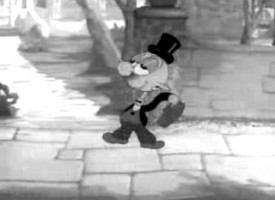 - Wiffle Piffle was a character that the Fleischer studio tried to develop out of the Betty Boop series. The first appearance was in a Screen Song: I Feel Like A Feather In The Breeze released in 1936. He appears as a waiter in the opening. The animation of the character was by Tom Johnson (as was this model sheet.)
- Wiffle Piffle was a character that the Fleischer studio tried to develop out of the Betty Boop series. The first appearance was in a Screen Song: I Feel Like A Feather In The Breeze released in 1936. He appears as a waiter in the opening. The animation of the character was by Tom Johnson (as was this model sheet.)
Two follow-up films were made with this side character in Betty Boop shorts.
The first, released in February 1937, was Whoops! I’m A Cowboy, and the second, in March 1937, The Hot Air Salesman. The opening scene features an expensive multiplane shot behind him.
He seems to have been an Egghead type character whose sole character trait was a silly walk. Needless to say, they couldn’t find a job for him.
The model sheet for the character was an 18 drawing walk cycle with a bit of a turnaround. Cross-hairs keep the character in registration; only a couple of the pages were punched.
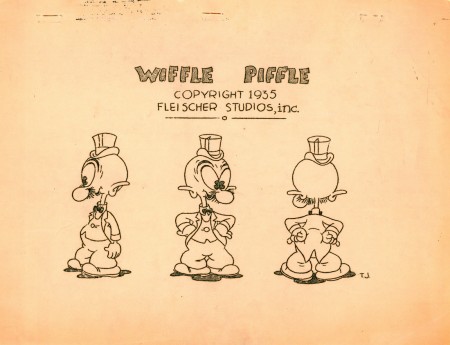 Wiffle Piffle walk cycle
Wiffle Piffle walk cycleOn ones at 24FPS
Click left side of black bar to play.
Right side to watch single frame.
Animation &Articles on Animation &Disney &repeated posts 14 Jun 2012 05:57 am
Marc Davis Interview
- On Tuesday, Andreas Deja posted a beautiful pair of drawings showing the transformation of Maleficent from a storyboard drawing to a Marc Davis animation drawing. The rise of draftsmanship, composition and performance was exhilarating. It reminded me of this interview with Mr. Davis which I posted back in June 2007. I’ve decided it’s a good time to post it again. Well worth rereading.
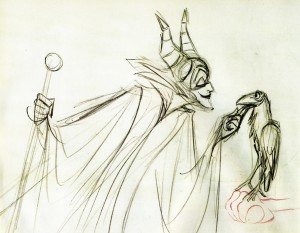 – Years ago I had a copy of a lecture that Marc Davis had given in which he compared the differences and the similarities between two characters he animated, Cruella De Vil and Maleficent. He discussed their motivations and their style of exposition. It was quite an extraordinary commentary, I’d thought, but somehow I seem to have lost that interview.
– Years ago I had a copy of a lecture that Marc Davis had given in which he compared the differences and the similarities between two characters he animated, Cruella De Vil and Maleficent. He discussed their motivations and their style of exposition. It was quite an extraordinary commentary, I’d thought, but somehow I seem to have lost that interview.
It was a great acting lesson from a great animator, and it seemed to offer depth that I haven’t found elsewhere. I’ve found myself paraphrasing from the comments Davis had made and thought to search for the document. I have found this interview that was conducted by A. Eisen for Crimmer’s: The Harvard Journal of Pictorial Fiction. This was published in 1975.
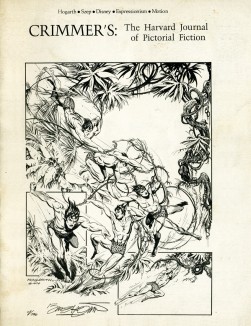 A
A 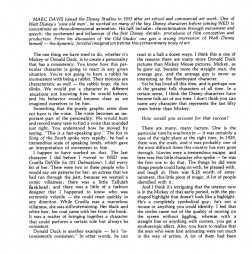 1
1
(Click any image to enlarge.)
There are other interviews with Marc Davis available. One of the best done with John Province seems to have been taken off line and now appears only in Didier Ghez‘s book, Walt’s People Vol. 1. It’s worth the book.
Animation &Animation Artifacts &Frame Grabs &UPA 22 May 2012 06:55 am
Nelly Bly’s Twisted Arms
This is one of my favorite scenes of all time. Nelly Bly is on the witness stand, and she’s constantly straightening herself out as she gets deeper and deeper into her side of the story. Grim Natwick’s animation is perfect, and John Hubley’s direction and design is even better. The judge, behind her, couldn’t be better positioned.
This is a great cartoon, possibly UPA’s best. It lost the Oscar to The Two Mousketeers, a Tom and Jerry cartoon, and not even a particularly good Tom and Jerry cartoon. It would take another ten years before AMPAS ruled that you had to see the short films to be able to vote on them.
I tried to include this scene with its soundtrack, but it took longer than I could afford to give it.
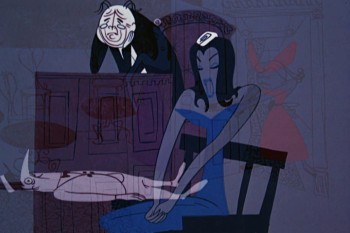 01
01
______________________
The bump in the middle is a hold wherein there’s a
camera move. I replaced it with a short dissolve.
Animation &Commentary &Hubley &Models &repeated posts 17 May 2012 07:17 am
Hub Eyes – repost
Here’s a post I wrote in 2009 that I still think is valuable, so I’m going to put it up again.
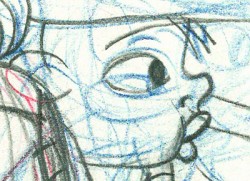 - It was 1973, and I was happily – I can’t tell you how happily – ensconced in the Hubley Studio working on Letterman, a new series for an upcoming CTW show, The Electric Company.
- It was 1973, and I was happily – I can’t tell you how happily – ensconced in the Hubley Studio working on Letterman, a new series for an upcoming CTW show, The Electric Company.
It was my first animation job. I inked it all (directly from animator roughs), I assisted & inbetweened it all, and I animated odd scenes including all the title sequences. I was a novice, and I was doing it all. Excited and happy is all I can remember.
I was alone one morning in the small room wherein I worked. I made a habit of getting into work before anyone and leaving after everyone. I wanted to make sure I was indispensible.
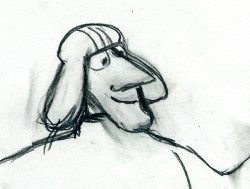 A month into the gig, and I think I’d only spoken with my hero, John, about a half dozen times. I was rushing through one of the Johnny Gent “Spellbinder” sequences. I inked all of his scenes, then inbetweened the drawings in ink. No time to work in pencil for this schedule. Johnny was completely off character, in a very old fashioned way, and I had to rework them all closer to the models – in ink. The schedule just gave me no time to be proud of what was happening. (A year or so later I apologized to Johnny for what I did to his artwork. I was so inexperienced and had such a dominant role in how the final art looked in that series.)
A month into the gig, and I think I’d only spoken with my hero, John, about a half dozen times. I was rushing through one of the Johnny Gent “Spellbinder” sequences. I inked all of his scenes, then inbetweened the drawings in ink. No time to work in pencil for this schedule. Johnny was completely off character, in a very old fashioned way, and I had to rework them all closer to the models – in ink. The schedule just gave me no time to be proud of what was happening. (A year or so later I apologized to Johnny for what I did to his artwork. I was so inexperienced and had such a dominant role in how the final art looked in that series.)
John Hubley ran in to give me something and made a quick comment about the character I’d been drawing. He said it was a “Paramount eye.” I looked at the drawing, then at him. Then John drew on a small piece of paper a “Disney eye,” then a “Terrytoon eye.” He laughed aloud and told me to try to “square off” the eyes a bit. Then he ran out.
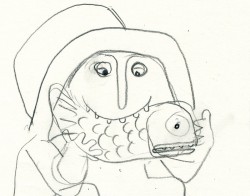 I learned a lot in a very short time. I watched eyes that day and probably all that week. I ran Hubley films at lunchtime (I’d made it a habit to project their films in the kitchen during many of the lunch breaks. The entire group working there enjoyed these sessions) and watched the eyes. I talked with Tissa David about eyes in one of our evening tutorials – she was trying to teach me how to inbetween properly.
I learned a lot in a very short time. I watched eyes that day and probably all that week. I ran Hubley films at lunchtime (I’d made it a habit to project their films in the kitchen during many of the lunch breaks. The entire group working there enjoyed these sessions) and watched the eyes. I talked with Tissa David about eyes in one of our evening tutorials – she was trying to teach me how to inbetween properly.
I was reminded of this moment when Chuck Rekow commented on the Moonbird Walk posted weeks ago. “The shape of the eyes on the boys is a real departure from almost anything in the cartoon world —even 50′s era. It’s closer to real life, and reminds me of the graphic style of Ben Shahn. It lends the film an aura of “seriousness”, even though it’s a cute film about two boys and an imaginary bird. Obviously, the pre-recorded sound is a major deal, but this gem is loaded with touches of inventive detail.”
How right he is, and I love being reminded of it.
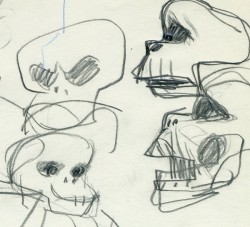 The eyes are the direct route to the soul of a person and, consequently, an animated character as well.
The eyes are the direct route to the soul of a person and, consequently, an animated character as well.
After working for the Hubley studio, for a short bit, I worked for Phil Kimmelman and Associates. This was a hardy commercial studio doing tight designer-based animation. Rowland Wilson was doing a lot of their design work, and the animation clean-up was tight. Animators Jack Schnerk, Sal Faillace and Dante Barbetta did a lot of the work the few months I was there. Jack Schnerk was also animating for Hubley, so I knew his very complicated-to-clean-up style. I worked primarily as an inbetweener and learned some hard and tight lessons while there.
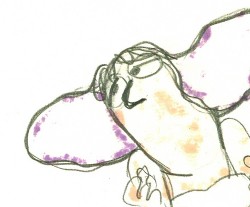 After the very loose work I’d been doing for the Hubley films, it was not only difficult for me, but good to keep me towing the proper line. I wanted to learn animation, and all of it was important.
After the very loose work I’d been doing for the Hubley films, it was not only difficult for me, but good to keep me towing the proper line. I wanted to learn animation, and all of it was important.
Here, too, an empahsis was on the eyes. No Disney eyes, no Hubley eyes, either. But now I was just concerned with keeping those lines tight tight tight. No shimmer on the eyeballs. After all, I was told, people stared into the characters’ eyes, and any flaws in the animation would show up first in those eyes.
I worked for PK&A for about three or four months. I’d also worked for Tubby the Tuba at NY Institute of Technology under Johnny Gentilella, where we got somewhat close and I was able to discuss all sorts of animation problems with him. That was the only redeeming element, everything else about that studio was wretched. My displeasure ultimately led to my leaving as soon as I could.
Eventually, I was back at the Hubley studio helping to finish up the short Cockaboody.
The tightening of my inbetwees only brought positives to what I could now do for John Hubley’s studio’s animation.
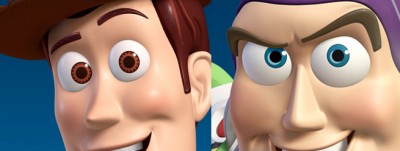 To this day, I still watch eyes closely. For some reason, the tighter the linework, the closer I watch the assistant’s work. The looser the line, the more I watch the design. I prefer watching the design. Often it means eyes that can be easily labelled: Disney, Paramount, or Terrytoons. I suppose today, you’d say: Pixar, Dreamworks or Blue Sky. (And believe me, you can see those differences even in cg.)
To this day, I still watch eyes closely. For some reason, the tighter the linework, the closer I watch the assistant’s work. The looser the line, the more I watch the design. I prefer watching the design. Often it means eyes that can be easily labelled: Disney, Paramount, or Terrytoons. I suppose today, you’d say: Pixar, Dreamworks or Blue Sky. (And believe me, you can see those differences even in cg.)
The images above are from the following films:
Animation &Books &walk cycle 10 May 2012 06:44 am
Terry – Cat Walk
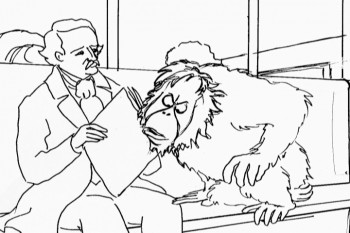 - Before going directly into the subject of today’s post, let me give a little twist toward our current on line promotion, Indiegogo.
- Before going directly into the subject of today’s post, let me give a little twist toward our current on line promotion, Indiegogo.
As you may know, we sought funds on Kickstarter a few weeks back trying to raise some cash to create a terrific trailer for POE, the animated feature we’re seeking to produce. That fund raising scheme wasn’t as successful as we’d hoped; money offered was not collected, and we’re taking what we’d learned and moved to a different venue, Indiegogo. There, we’ve started from scratch.
POE is a film we’d like to produce and are hoping we’re not too far from the starting gate. SSince we’ve developed a script, drawn a storyboard, created about 20 minutes of animatic (story reel) from the few voices we’d recorded, the next and most likely step would be to animate some of it and get it to our sales group to help raise the necessary capital. That’s where we are. If you’ve already given your support to this project, I thank you sincerely. If you’re not aware of it, I encourage you to look at the website for POE, poestory.net, or the Facebook page, or Indiegogo where all the action is happening. Moral support is almost as good as financial. If you’d like to tell any of your friends about it. I’d appreciate that too. In all, I have to say Thank you for your help.
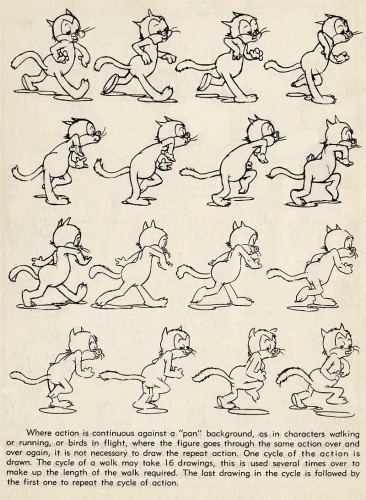
- Stephen Worth at Animation Resources recently posted anew his copy of Nat Falk’s How To Make Animated Cartoons. When I was a kid I cherished my copy of this book – actually it was a library booik, but I was the only one who ever checked it out of my local library, and I basically had it out permanently. There was something about those clumsy looking Terrytoon drawings that I absolutely enjoyed. (Don’t forget that the Mighty Mouse Show was one of the very first Saturday morning TV shows, and every kid my age was affected by it.)
Aside from all the information about studios and drawing characters etc., there were the pages where you could see the animation drawings all lined up, just as in the Preston Blair book. It was something I didn’t take lightly. I always was curious how those cycles pictured moved. The one, above, was one that stood out in my memory. I always thought it eccentric and was curious to see it in action.
Well, now I can do it given the simple technology at hand. So I put the page through Photoshop and layered the drawings, then dragged it past AfterEffects, and behold a QT movie. Here’s the results, pictured below:
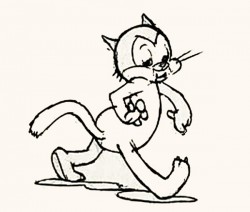 1
1
And here’s the QT movie of the cycle.
It’s on two’s, and
it’s not a pretty picture.
I think Carlo Vinci may have animated it.
I did a similar thing, in a different post, using another walk cycle from this book. That was done in 2009. A cycle of “Puddy the Pup.” That worked a little better but not by much.
Animation &Animation Artifacts &Disney 25 Apr 2012 06:44 am
Roger’s Dance Sc.91
- Here’s the last of the scenes I have from 101 Dalmatians. Roger, singing the “Cruella de Vil” song, pulls Anita to the dance floor and does a quick step with her. She’s reluctant but moves along with him. It’s a complex scene full of character – actually, two characters, and Milt Kahl handles it brilliantly, as expected.
Here’s sequence 2, scene 91.
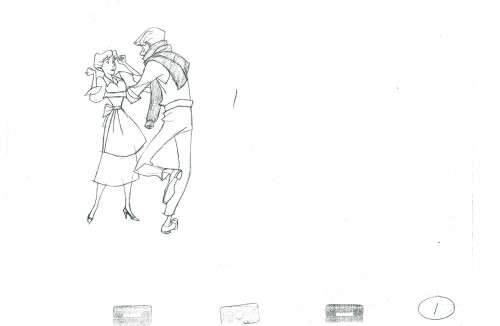 1
1
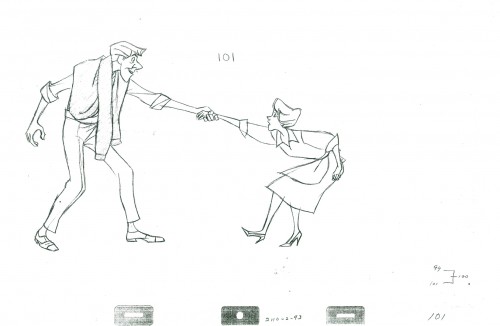 101
101
From here on inbetweens are left for the Asst.
______________________
The following QT includes all the drawings posted above.
There’s a bit of distortion in the Xerox copies
so the registration goes in and out.
Click on the right side of the lower bar to watch it one frame at a time.
Animation &Animation Artifacts &Bill Peckmann &Disney &Illustration &Rowland B. Wilson 19 Apr 2012 07:18 am
Rowland Wilson Scrapbooks
- Suzanne Wilson sent me some pages from the private scrapbook that Rowland B. Wilson kept for inspiration and reference. Seeing these pages, I was a bit surprised at what he collected. When I was a kid, I kept a scrapbook of everything – and I do mean everything – that was printed about animation. Remember, there were few books about animation back in the 60s; I had to hold onto everything available. I found looking at Rowland Wilson’s scrapbook not too different from my own, except that he kept material about the “Golden Years”. It gave me a smile.
Here are some of Suzanne’s comments:
- Rowland B. Wilson, ever the contrarian, once said when speaking of deciding one’s future “Why should you expect an eight-year-old boy to decide what a grown man should do?†He may have been a bit older than that (dates of the periodicals suggest age 12 through 15) when he assembled scrapbooks of his favorite subjects and illustrations from Disney, Life, Collier’s and Look magazines and the Dallas newspapers, but one look shows the premonition of a later artistic sensibility. He zeroed in on what exactly appealed to him visually and subjectively and never deviated. The influences were taken to heart and incorporated into a personal recognizable style.
For example, “Speaking of Picturesâ€, a Disney spoof on the Old Masters (Image 15) clipped from Life Magazine in 1945 can be compared to The Sneezenfitz Gallery, drawn in 2005 for the cartoon novel “Cloak and Pistolâ€. One only has to look at “Casey at the Bat†(Image 16 to see a gestalt that was to emerge in the definitive baseball players in TV Guide. (See Rowland B. Wilson TV Guide Originals-1, posted February 16th.)
The clippings can also be seen as interesting ephemera. Those from wartime show aircraft insignia designed by Disney, aviation gremlins and advertising of the time.
Here are some comments from Bill Peckmann, who requested Suzanne send me the material:
- I have to admit it’s been over 35 years since I last laid eyes on them when Rowland brought them in to PK&A for show and tell. He had just returned from a trip to his hometown of Dallas, Texas and couldn’t wait to show us what he brought back with him. This was just about the time in the 70′s when Disney was starting to come back into the good graces of the art world again. (Think Lincoln Center.) I remembered there was Disney and other great stuff in there, but couldn’t quite remember exactly what. Seeing the collection now after all these years, it feels like I’m looking at a precursor to the SPLOG. One can see now what a terrific eye and good taste Rowland had as a young teenager, and it’s also neat to see that animation was in his blood at such an early age, he just got a little sidetracked with very successful advertising, cartooning and illustrating careers before he went back to the first love of his life, animation. Lucky us!
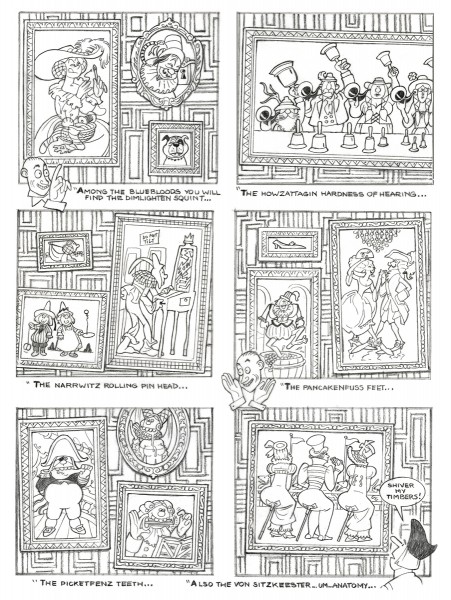 1
1
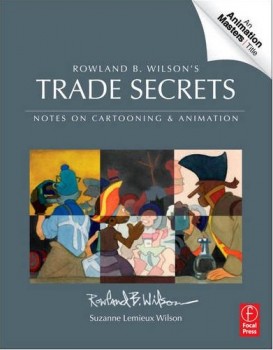 Suzanne Wilson is about to have a new book on the market: Rowland B. Wilson’s Trade Secrets: Notes for Cartooning and Animation.
Suzanne Wilson is about to have a new book on the market: Rowland B. Wilson’s Trade Secrets: Notes for Cartooning and Animation.
It’s obvious that this book is directly related to this post. Rowland Wilson obviously kept journals in which he wrote about illustration and animation, and the information must certainly be very informative to students; some of these journals are published here. Presumably pages of the scrapbook may have made the book.
The book seems to offer quite a bit of attention to Mr. Wilson’s animation art, just as it does his brilliant illustration and cartooning. I look forward to getting my copy.
